



























DUBLIN FIRE
LIAM MACGABHANN’S CAREER NUMBER 1

BRIGADE’S SENIOR MAN















THE IRISH DEFENCE FORCES THE YEAR IN REVIEW









































DUBLIN FIRE
LIAM MACGABHANN’S CAREER NUMBER 1

BRIGADE’S SENIOR MAN















THE IRISH DEFENCE FORCES THE YEAR IN REVIEW




















When a child loses their home, they lose their entire world.


There are almost 4,000 children homeless in Ireland. Donate now. focusireland.ie 1850 204 205






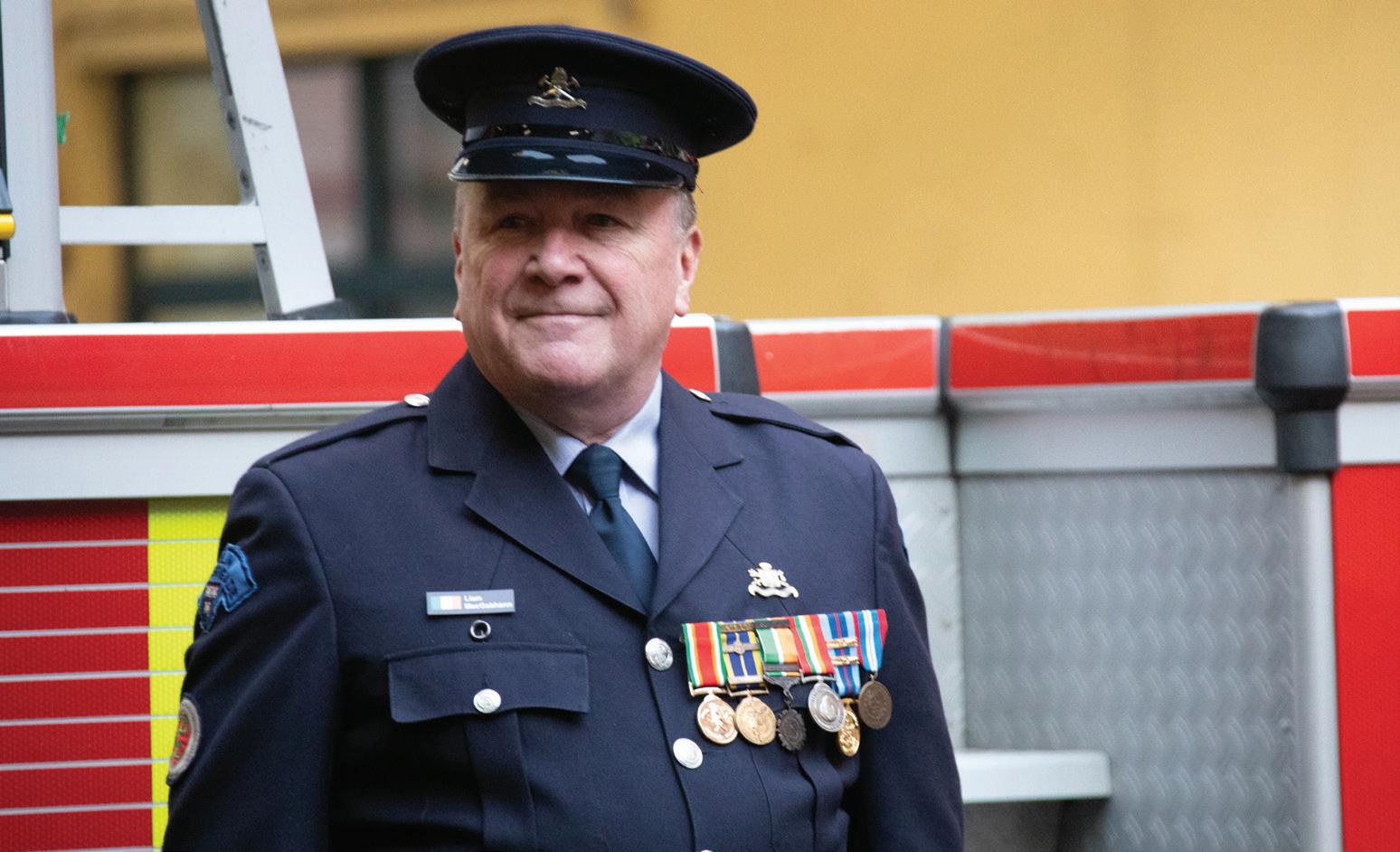





Dear readers,
Editor: Adam Hyland
Contributors: Adam Hyland
Creative Director: Jane Matthews
Cover Credit: Adam Hyland
Photography:
HSE, NAS, Adobe, Adam Hyland, Óglaigh na hÉireann/Irish Defence Forces, An Garda Síochána, Road Safety Authority, Dublin Fire Brigade, Coast Guard, Liam MacGabhann, Gallery Books, O’Brien Press, Sitric Books/Lilliput Press, Sandycove, Dräger, CheckFire, ATOR Labs, New Horizon Aircraft.
Production Executive: Claire Kiernan
Publisher:
Ashville Media Group, Unit 55, Park West Road, Park West Industrial Estate, Dublin 12, D12 X9F9.
Tel: (01) 432 2200
Fax: (01) 676 6043
Managing Director: Gerry Tynan
Chairman: Diarmaid Lennon
Publisher’s Statement:
The information in Ambulance Ireland is carefully researched and believed to be accurate and authoritative, but the Publisher cannot accept responsibility for any errors or omissions. Statements and opinions expressed herein are not necessarily those of the Editor or the Publisher. Copyright © Ashville Media Group Ltd. No part of this publication may be reproduced, stored in a retrieval system or transmitted in any form or by any means without written permission from the Publisher.
Welcome to the 2025 edition of Ambulance Ireland. As always, we bring you the latest news and features covering Ireland’s medical and emergency services sectors, as well as interesting and inspiring stories from our frontline personnel and from around the globe.
In these changing times, one thing that is permanent is the dedication and commitment of all emergency service and frontline personnel, and we must remember that a huge amount of thanks must go to those people who help keep us safe. Thanks must also go to all who gave their time to make the features in this issue possible.
Comdt Dr Fiachra Lambe of the Defence Forces Medical Corps made history this year when he became the first ever graduate of the Higher Specialist Training scheme in Military Medicine. Now a member of the Faculty of Military Medicine in Ireland, his dual specialist qualification alongside General Practice has seen him provide medical care to defence forces personnel at home and abroad, and in this issue he shares his story in what is a fascinating read. Sincere thanks to him for taking the time to talk to me.
Life as a first responder presents challenging but also rewarding situations, and having served as a Firefighter/ Paramedic with Dublin Fire Brigade for 40 years, recently retired Liam MacGabhann has many stories to tell. In this issue, we profile the man who was Badge Number 1, the most senior operational firefighter in the organisation, where he talks about life on the ambulance and the fire engine, his long career with the Army Reserve, and the advice he would give to anyone thinking about becoming a first responder.
We also take a look at the Dublin Fire Brigade Training Centre in Marino, north Dublin, to see how it has transformed into an educational centre of excellence for firefighting and paramedic training through major investments in expertise and technology. Also included are a review of the Defence Forces and Coast Guard’s year to see just what is involved in protecting us and keeping us safe on land and at sea.
Elsewhere, we look at the latest road safety stats and campaigns, the new HSE Health App and National Service Plan, key health trends in Ireland, and see what’s new in the world of emergency services technology.
Best wishes,
THE YEAR IN REVIEW The Irish Defence Forces
NUMBER 1
Dublin Fire Brigade’s Most Senior Man Liam MacGabhann’s Career
ADVANCING MILITARY MEDICINE
Ireland’s First Graduate of the Higher Specialist Training scheme in Military Medicine, Comdt Dr Fiachra Lambe
Outgoing Minister for Health Stephen Donnelly appointed two members to the Pre-Hospital Emergency Care Council in January. Shane McGlinchey joined the NAS 16 years ago as a paramedic and gained a Diploma in Emergency Medicine Technology from UCD, then a Graduate Diploma in Emergency Medicine in 2012, to become an advanced paramedic. He is Advanced Paramedic Supervisor at Killybegs Ambulance Station, and is in the final year of a degree in Occupational Safety and Health. Alison Smith has been re-appointed to the Council. She graduated in 2001 with a Bachelor of Science degree and joined the NAS in 2011, then completed a Diploma in Emergency Medical Technology in 2013. She completed a Graduate Diploma in Emergency Medical Science in 2019, undertook instructor training with the Crisis Prevention Institute and joined the NAS Incident Response Team. In 2020, Alison completed a NFQ Level 8 in Critical Incident Stress Management and is CISM Coordinator for Mountain Rescue Ireland.
Members of the Defence Forces will now be granted statutory rights on daily breaks, weekly rest, maximum working time over a given period and annual leave, in line with workers in other industries and services. The EU directive on working time came into e ect for the Defence Forces earlier this year, in line with the Organisation of Working time Act 1997. Minister for Enterprise, Trade and Employment Peter Burke signed the European Communities (Organisation of Working Time) (Defence Forces) Regulations 2025 to extend the 1997 Act. Chief of Sta of the Defence Forces, Lieutenant General Seán Clancy, described the development as marking “a pivotal moment” in continuing e orts to improve working conditions in the forces. “By aligning with contemporary workplace standards, we’re not only improving the quality of life for our current members, but also making the Defence Forces a more attractive career option,” he stated. Due to their specific nature, some military activities will be exempt from the provisions of the Working Time Directive, but Government has vowed to implement “appropriate health-and-safety protections”, including prescribed compensatory rest periods, for those involved in such tasks.
The National Ambulance Service (NAS) received more than 250 hoax 999 calls in the first ten months of 2024. According to data shared under the Freedom of Information Act, the country’s ambulance service run by the HSE answered 253 such calls between 1 January and 1 November last year. Most hoax calls were made in February, when 49 incidents were reported. The second highest number occurred in September, when the NAS received 47 hoax calls. In July, 30 fake calls were answered, while in April, 24 were recorded, 21 in May, 19 in August, 18 in October, 17 in June, and 16 in March. The lowest number of hoax calls were made in January, when 12 incidents were reported. In total, the NAS answered 353,070 emergency calls between January and the end of October 2024, an average of 35,307 per month. Emergency calls spiked in January, March, May and October, when on average there were at least 35,600 calls made each month. A spokesperson for the NAS said the hoax calls ranged from abuse targeted at call-takers to pranks. “We treat every call as genuine and urgent and cannot assume that any call is a prank,” the spokesperson said. “Hoax calls range from abuse to our controllers down the phone to ambulances being dispatched only to have nothing found at the location. Hoax calls divert resources away from genuine emergencies and can delay responses to patients who are seriously ill or injured. An ambulance on its way to a hoax can’t be on its way to you or a loved one.”
The HSE is undertaking a major overseas marketing campaign to recruit consultants including more than 50 emergency medicine specialists to work in Ireland. Targeted marketing in Australia and New Zealand, close collaboration with training colleges and the Medical Council, and “bespoke marketing campaigns” are being put in place to attract qualified personnel to posts that have been challenging to fill. According to the HSE National Doctors Training and
Planning (NDTP) Emergency Medicine Workforce in Ireland 2024-2038 report, it will be necessary to recruit 50-55 additional EM consultants from outside of the Irish training programme over the next five-tosix years. According to the NDTP report on the EM workforce, there were approximately 182 wholetime equivalent (WTE) consultants working in HSE-funded services in June 2024. This figure would need to increase to 335 WTEs by 2038 to meet patient demand.
New Minister for Health Jennifer Carroll MacNeill announced the establishment of a Genome of Ireland research project in January that will establish a genomic dataset of at least 1,200 individuals living in the country. The project will be part of a larger Genome of Europe project that will create a European repository of genetic information, or a digital representation of all the DNA in the human body, that aims to advance personalised medicine, disease prediction, and prevention, as well as supporting public health policies and medical research to improve diagnosis and treatment continent-wide. It encompasses 49 partner institutions across 27 European countries and will reflect European genetic and ancestral diversity by country.
Emergency response charity CRITICAL, which now operates across 25 counties, saw a 45% increase in calls to its service last year, with Waterford and Donegal recording the most calls. Doctors and community first responders with the charity that supports HSE ambulances, were called to a range of emergencies including chest pain, stroke, cardiac and respiratory arrest, falls and road accidents. The Donegal branch of CRITICAL had 230 calls in total, while Waterford had 187, Cork had 159, and Tipperary had 119 calls. Overall, the charity responded to 1,308 incidents after 999 emergency calls were made, an increase from 900 calls in 2023. New units were set up last year, including Carrick-on-Suir in Tipperary and Blackwater in north Cork, and more volunteer groups are planned for this year. This scheme has been in operation for almost 20 years and sees o -duty paramedics and other sta respond to local emergencies.
Older adults in this country experience positive levels of health and wellbeing, according to the latest Health at a Glance: Europe 2024 report published by the Organisation for Economic Cooperation and Development. Ireland has one of the highest rates of estimated healthy life years for those over 65, at 11.6 years, compared to the EU average of 9.1 years. It also has one of the lowest rates of people over 65 reporting to be in bad or very bad health at 9.2% compared to an EU average of 18.5%. A life expectancy of 82.6 years is the seventh highest in Europe, above the average of 81.5 years.

In an aim to modernise its ambulance fleet, the Spanish Army’s Logistics Support Command is looking to acquire up to 350 new vehicles over the next four years, at a cost of €93million. The tender, which closed last December, is intended to replace older vehicles, ensure ambulance coverage for military units, and provide healthcare capabilities in national and operational zones. This initiative is divided into two separate contracts. The first consists of 50 road ambulances, including 14 configured for Advanced Life Support (SVA) and 36 for Basic Life Support (SVB), at a cost of €12million. The second contract involves 300 all-terrain ambulances, evenly split between SVA and SVB configurations, valued at €81million. Unit prices range from €145,000 for SVB road ambulances to €278,300 for SVA all-terrain ambulances. As part of this modernisation e ort, the Army ordered six high-mobility armoured ambulances in August 2024 from the Spanish manufacturer Urovesa. These vehicles, part of the Vamtac ST5 series, were purchased for €4.6 million. The ambulances include a medical cell equipped with electromedical devices, diagnostic tools, immobilisation equipment, and treatment supplies. They also feature armour for the cabin and medical compartment to protect against ballistic threats and mines, as well as NBC collective protection systems. The vehicles are designed to cross watercourses up to 1.5 metres deep.

The UK capital is to get its first dedicated air ambulance to operate out of London Biggin Hill Airport, some 15 miles south of Charing Cross. Operated by SkyCare Repatriation, the Pilatus PC-12 NGX air ambulance will provide critical care transport for health services, insurance providers and self-funding patients. The ambulance a ords operators the ability to cover a whole range of assignments with a single-aircraft type, including surveillance, medical assistance, cargo transport and search and rescue. Tools and features include enhanced graphical displays, weather on the vertical situation display, full ADS-B In functionality, 3D audio, detailed 2D airport moving maps, and a SmartRunway and SmartLanding awareness and advisory system.

The Health Minister of Kazakhstan, Akmaral Alnazarova, has announced that she is exploring the possibility of equipping ambulance doctors and paramedics with body-mounted video cameras to address increasing aggression against medical workers. More than 150 incidents of attacks on ambulance personnel have been reported over the last four years in the country. Kazakhstani police have used bodycams since 2017 to ensure accountability in law enforcement, and Minister Alzazarova says issuing emergency workers with the same equipment will protect employees and document incidents of violence. The urgency of this measure was highlighted by a recent incident in the town of Kostanay, where a paramedic was assaulted by relatives of a deceased patient. The assailants, against whom a criminal case has been opened, allegedly obstructed resuscitation e orts. The paramedic su ered a concussion and required hospitalisation.

A 65-year-old man has reportedly come back from the dead in Maharashtra’s Kolhapur district in eastern India after the ambulance taking him from hospital to his home went over a speed bump. Pandurang Ulpe su ered a heart attack and was rushed to a private hospital where he was declared dead last December. As he was being returned home where friends and neighbours had gathered to prepare him for his last rites, family members noticed his fingers moving after the vehicle went over a speed bump. He was immediately taken to another hospital, where he remained in recovery for two weeks, undergoing an angioplasty before he walked home to his family. The hospital that declared him dead made no comment on the incident.

Last year was another busy and eventful 12 months for the Irish Coast Guard, according to the organisation’s annual end of year summary of statistics, with more than 2,500 incidents recorded. e incident count of 2,554 recorded by the 44 Irish Coast Guard Units covers the range of services provided by the maritime emergency organisation, including search and rescue, maritime casualty responses and pollution and preparedness responses. e Coast Guard also assisted An Garda Síochána in open country missing person searches and mountain rescue, the National Ambulance Service in providing an Air Ambulance and Helicopter Medical Emergency Service (HEMS) both inland and to island communities, as well as provision of other supports to the Emergency Services.
Units were mobilised on 1,154 separate occasions in 2024, with helicopters operating out of bases at Dublin, Waterford, Shannon and Sligo conducting a total of 752 missions. Coast Guard helicopters also conducted 134 air ambulance ights in support of the o shore island communities, as well as provision of other supports to the Emergency Services.
It also collaborated with the wider search and rescue community throughout 2024, with the three Irish Coast Guard Maritime Coordination Centres in Dublin, Malin and Valentia tasking Royal National Lifeboat Institution (RNLI) lifeboats on 699 occasions, while the community inshore rescue service was also launched on 73 missions.
In terms of lives saved, which the Coast Guard de ne as “assistance provided that prevented loss of life, severe risk to life, and/or delivery to appropriate medical care”, critical assistance was provided to 537 persons over the course of the year.




e Irish Coast Guard also saw signi cant expansion in 2024, with the rst two AW189 helicopters provided by Bristow Ireland Limited under the new aviation service contract commencing operation in Shannon in the last month of the year. Four further helicopters have now been delivered and prepared for mission readiness in the rst half of 2025. e Coast Guard also looks forward to welcoming the rst xed-wing aircra to the IRCG eet.
e priority of the phased transition to the new contract was ensuring the safety of the helicopter crews, Irish Coast Guard members and other stakeholders who will be working alongside the helicopters. is important milestone was achieved through positive collaboration between the two contractors and the Department of Transport and support from the wider search and rescue community.
With the ongoing public safety message of having the capacity to Raise the Alarm and Stay A oat central to the prevention of drownings at sea, along the coast and on inland waterways, the Coast Guard’s core message of Stay A oat – Stay in Touch continues to be shared on www.safetyonthewater. gov.ie and across multiple media, and highlights the importance of never engaging in any commercial or
It outlines that practical and simple steps can save lives, such as checking the weather forecast and times of tides for your local area; swimming at lifeguarded beaches and within your depth; and ensuring that you have the right equipment for the water-based activity you are about to undertake, will help ensure you return home safely.
A campaign called TravelWise was also launched in conjunction with the Department of Foreign A airs to highlight water safety for those

recreational boating activity without wearing a life jacket or Personal Flotation Device, coupled with the capacity to raise the alarm via VHF radio, Personal Locator Beacon (PLB) or EPIRB.
e message also makes clear that any maritime or coastal activity should be supported by informing shore-based colleagues of intended activity and anticipated return time. Mobile phones, it stresses, should not be considered a suitable substitute or be relied upon as the only means of emergency communication at sea.
A series of awareness campaigns across the major Bank Holidays were launched to underline this safety message, with the Be Summer Ready campaign introducing the message of ‘ ink Water Safety - Plan & Prepare’.
travelling abroad to pursue water activities in 2024.
Speaking about the annual report, Ms Joanna Cullen, Assistant Secretary General at the Department of Transport with responsibility the Irish Coast Guard, said:
“2024 was an important and busy year for the Irish Coast Guard. I want to thank all members of the Irish Coast Guard who have once again shown their dedication to keeping the Irish coastline safe. I want to particularly extend my appreciation to the sta in the three Maritime Rescue Coordination Centres, who remain vigilant both day and night and ensure our critical work continues, especially during the Christmas period when others enjoy some time o with family and friends.”
































Although the total number of fatalities on Irish roads fell by 4% last year, the start of 2025 saw alarming gures as, by the end of February, there was, on average, a road death recorded every two days. is highlights the ongoing challenge faced by An Garda Síochána to realise the Vison Zero target of no fatalities on our roads by 2050.
By the end of the eight week of the year, 24 people had lost their lives on Irish roads, which included 14 drivers, one passenger, six pedestrians, two motorcyclists and one pedal cyclist.
Over the course of 2024, 174 people were killed on our roads as a result of a total of 160 fatal collisions. ough this is down from 181 in 2023, it is still far too high, and with increased roads policing numbers and man-hours deployed, it points to an element of recklessness by road users that An Garda and Government are continuously trying to address.
Dublin (23), Mayo (19), Cork (19) and Donegal (17) recorded the highest number of deaths last year, accounting for 45% of all fatalities, with a high proportion of those being young male drivers (35% were 25 or younger).
FOCUS
Speaking in January when the statistics for 2024 were published, Minister of State with Special Responsibility for Road Safety, James Lawless, outlined the focus the new Government is putting on improving these

gures to reduce the number of avoidable tragedies on Irish roads.
“Every single one of these deaths on our roads is a tragedy,” he said. “We extend deepest sympathies to the friends, families and communities a ected by these losses. I would also like to pay tribute to the emergency services, rst responders, hospital workers and others who do such incredible work helping people on scene and in the a ermath of these events.
“ e work of my Department is focused on making our roads safer for everyone who uses them. is year we will also be moving into Phase 2 of the Government’s
Road Safety Strategy, and it is incumbent on all of us to play our part in achieving our goal of halving deaths and serious injuries by 2030.”
Sam Waide, Chief Executive of the Road Safety Authority (RSA), said: “With heavy hearts, we mourn the loss of 174 lives to road tra c collisions this year, and our deepest thoughts are with the devastated families le grieving a loved one in 2024, including at Christmas. Despite this profound loss, the reduction in the number of fatalities on Irish roads this year is a very

WE MUST HARNESS MORE TECHNOLOGY, DELIVER IMPACTFUL AWARENESS
CAMPAIGNS AND CONTINUE ROAD SAFETY EDUCATION, TO CREATE A SAFER FUTURE FOR ALL ROAD USERS IN IRELAND”
modest but important step in reversing the high number of road deaths we’ve seen over the past two years. is progress underscores the urgency to intensify our e orts. To truly turn the tide, as part of the Government’s Road Safety Strategy, we must harness more technology, deliver impactful awareness campaigns and continue road safety education, to create a safer future for all road users in Ireland.”
Assistant Commissioner Paula Hilman, Roads Policing and Community Engagement, An Garda Síochána, added: “ is slight reduction in the number of road fatalities on Irish roads, is of no solace to the families and loved ones of each one of the people that were killed in fatal road tra c collisions during 2024. I extend my deepest sympathies to all of those a ected and at what must be a devastating time.
“An Garda Síochána has been working around the clock every day of this year to help keep road users safe. at work spans both education and enforcement. Gardaí have delivered our Lifesaver Project to thousands of adults and teenagers nationwide during 2024 in a hope of highlighting the dangers of poor driver behaviour, and over the next twelve months we will extend that further.
“Gardaí have conducted more than 100,000 checkpoints on Irish roads this year, half of which were Mandatory Intoxicant Testing. We continue the roll out of safety speed cameras in high-risk locations and are already seeing positive indications that drivers are slowing
IT IS INCUMBENT ON ALL OF US TO PLAY OUR PART IN ACHIEVING OUR GOAL OF HALVING DEATHS AND SERIOUS INJURIES BY 2030”
down in these areas. We also continue to maximise the technology available to us to support data driven roadside policing including Mobility Devices and Automated Number Plate Recognition systems in Garda vehicles.
“As members of An Garda Síochána we cannot achieve any meaningful reduction in the number of people killed on Irish roads without the public’s full support. As we enter a new year, we urge all drivers to drive safely and slow down.”
Minister of State Lawless also outlined some of the measures that are being put in place to improve road safety this year, most notable of which is the reduction of speed limits on hundreds of rural roads throughout the country, from 80kmh to 60kmh, which came into e ect in February.
“ e default speed limit on rural local roads will be reduced, following the recommendation of the 2023 Speed Limit Review,” he said. “ is will tackle one of the biggest contributory factors to road collisions: Speed.”
e speed limit in urban areas such as housing estates and town centres is also set to be reduced from 50kmh to 30kmh this year, with limits on national secondary roads reducing from 100kmh to 80kmh.
Minister for Transport Darragh O’Brien said: “ is speed limit reduction will save lives, because driving slower saves lives. Driving at a lower speed means that if you get into a collision, either as a driver or a vulnerable road user, death or serious injury is a signi cantly less likely outcome. It also means you are less likely to be involved in a collision at all.
“Death and serious injuries on our roads
are not inevitable, they are preventable through tangible, sensible measures. is Government is taking action to reduce road fatalities and serious injuries.”
Minister of State at the Department of Transport Sean Canney said: “Today’s speed limit change is an outcome of many years of consultation, deliberation and engagement across the system, most notably from the evidence base of the 2023 Speed Limit Review and close collaboration with local authorities who are implementing this reduction. is welcome change will give us all safer roads.
“Systemic changes like this speed limit reduction and road safety education –along with enforcement – have helped us signi cantly bring down road deaths, but in recent years this trend has worryingly reversed. Together, we can make our roads safer, by observing the speed limit, driving safely and looking out for one another on rural local roads.”
e new Government also announced an investment programme of €713million for regional and local roads for this year, part of which will go towards improving the condition of roads throughout the country to reduce the number of collisions.
Minister of State Canney said: “ is crucial funding will enhance road safety, with funding being allocated for over 330 safety projects this year, an increase of 20% from last year. ese safety schemes aim to implement remedial measures to improve the overall safety of our road network, bene ting all road users. Increasing funding in safety projects is vital in reducing road fatalities and serious injuries, and helps to create a safer transport environment for all.” ese upgrades and improvements can’t come soon enough, but they need to be combined with driver education and strictly enforced penalties to get the message across that reckless or dangerous driving can be lethal – something that many road users just don’t seem to be taking on board.
is can be seen in the gures released by An Garda Síochána following the rst major roads policing operation of 2025, which took place over the St Brigid’s Bank Holiday Weekend, beginning on ursday,
30 January and concluding on Tuesday, 4 February.
Gardaí conducted both statutory Mandatory Intoxicant Testing (MIT) and regular, high-visibility policing checkpoints during this time, with just under 200 drivers arrested on suspicion of driving under the in uence of an intoxicant (alcohol and drugs). Frighteningly, more than 2,200 drivers were detected for speeding o ences during the ve-day operation. is was despite the fact that fewer people were on the roads because of the e ects of Storm Eowyn.
Some of the more notable speeding o ences included a vehicle travelling at 126kmh in a 60kmh zone in Limerick, a vehicle travelling at 142kmh in an 80kmh zone, also in Limerick, a vehicle travelling at 166kmh in a 100kmh zone in Wicklow, a vehicle travelling at 190kmh in a 100kmh zone in Mayo, and a vehicle travelling at a staggering 206kmh in a 120kmh zone in Galway.
With this in mind, further measures are being taken this year in addition to the reduction in speed limits. Average speed cameras will have an increasing presence on Irish roads as they are being introduced on a phased level, while from the end of March, all motorists must provide their Driver Number and that of any named drivers to their insurer to cut down on uninsured drivers on our roads.
is year will also see the introduction of new cameras at tra c lights to catch motorists breaking red lights. A phased approach will see cameras brought in to Dublin rst before being rolled out across the country, with nes of €80 being processed automatically.
Government is also considering the introduction of re-education courses for drivers caught speeding, while the Department of Transport has proposed a review of the graduated penalties approach to speeding and other road tra c o ences. Let’s hope that, as the year progresses, these steps will see a reduction in the needless loss of lives on our roads, but as always, it is up to the public to heed the strong messages being issued by An Garda Síochána and the RSA and to drive safely and carefully.








Suppo r t loc a l to l i ft us a l l




All Ri s e All Ri s e


Ch am p i o n G r ee n . i e









Cuan Mhuire is Ireland’s largest multi-site provider of Detoxification & Treatment for Alcohol, Drug & Gambling Addiction.
Cuan Mhuire has CHKS Accreditation & ISO 9001:2015 Certification
It has Residential Treatment Centres at:
Athy, Co. Kildare T: 059 8631493
E: athy@cuanmhuire.ie
Bruree, Co. Limerick T: 063 90555
E: bruree@cuanmhuire.ie
Coolarne, Co. Galway T: 091 797102
E: coolarne@cuanmhuire.ie
Farnanes, Co.Cork T: 021 7335994
E: farnanes@cuanmhuire.ie
Newry, Co Down, BT35 8RL, United Kingdom T: 0044 2830849010
E: newry@cuanmhuire.ie


The Defence Forces Saw Developments at Home and Abroad in 2024
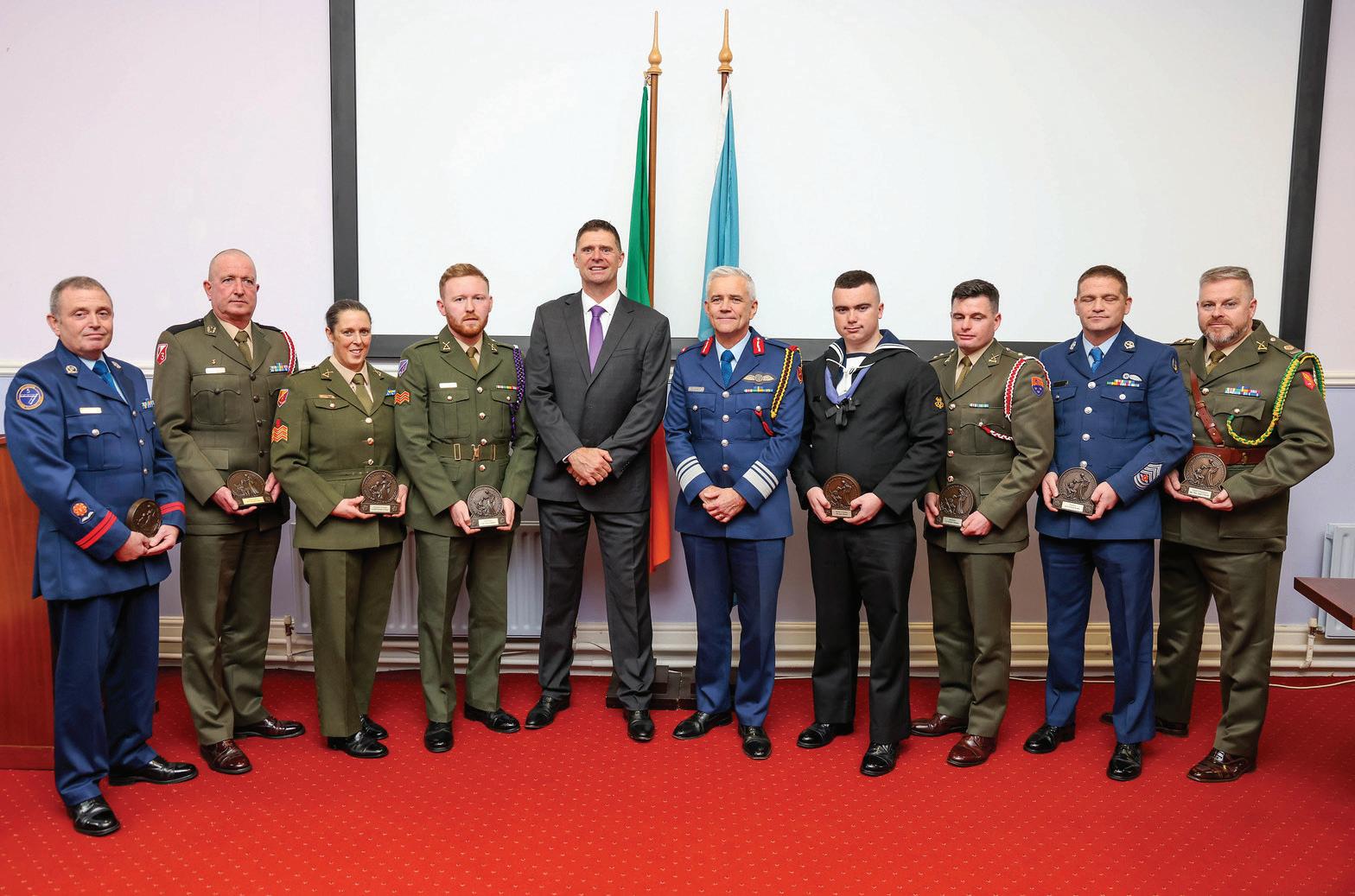



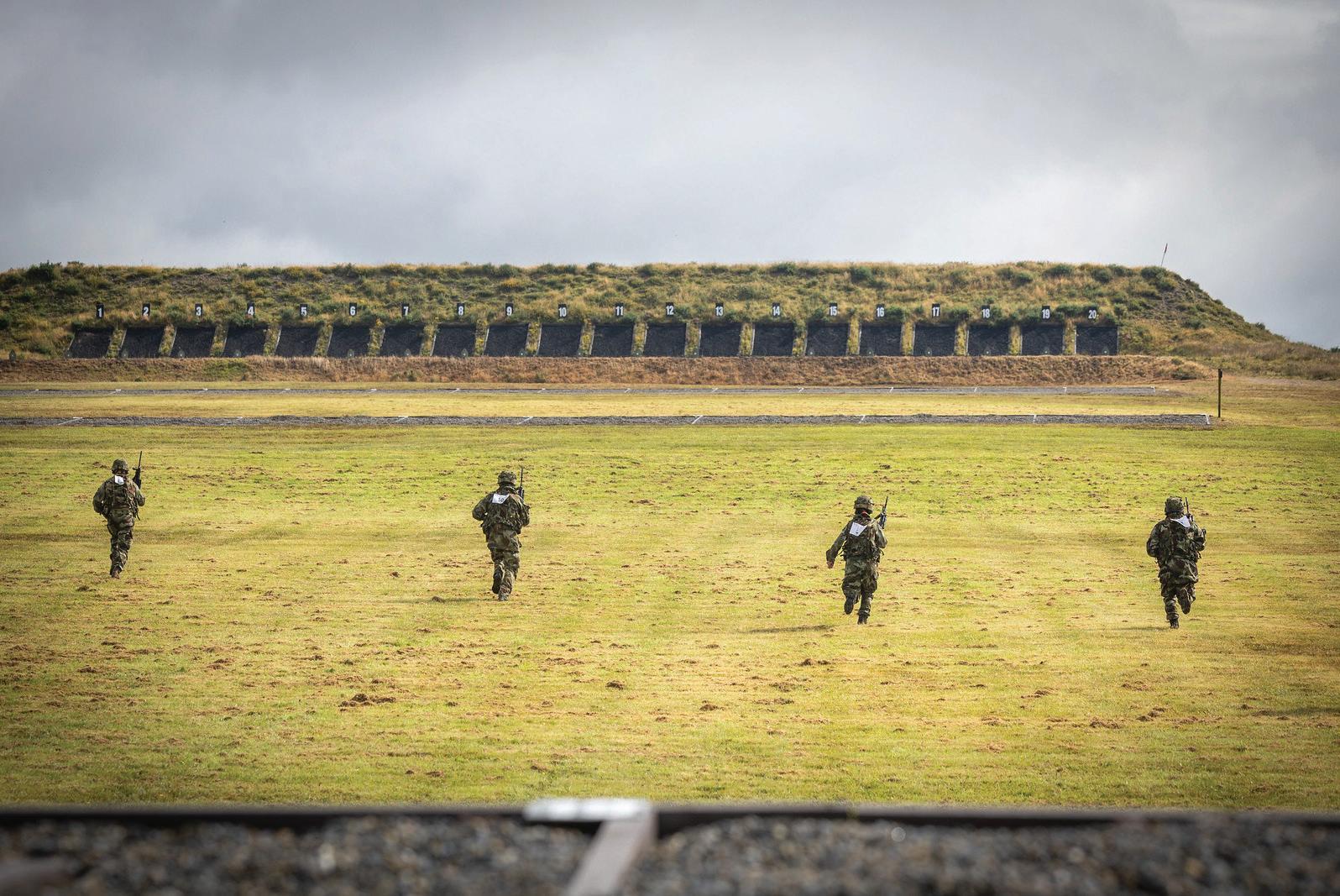
This year, the Irish Defence Forces shared with the public the main events of last year in a di erent fashion. Rather than releasing a detailed statement recapping the main activities of the Army, Air Corps and Naval Service in 2024, in January the Defence Forces press o ce released a highlight reel on social media, marking out key moments over the course of 12 months.
e main story from January was the updating of personal appearance standards for all Defence Forces personnel. is move was “to introduce

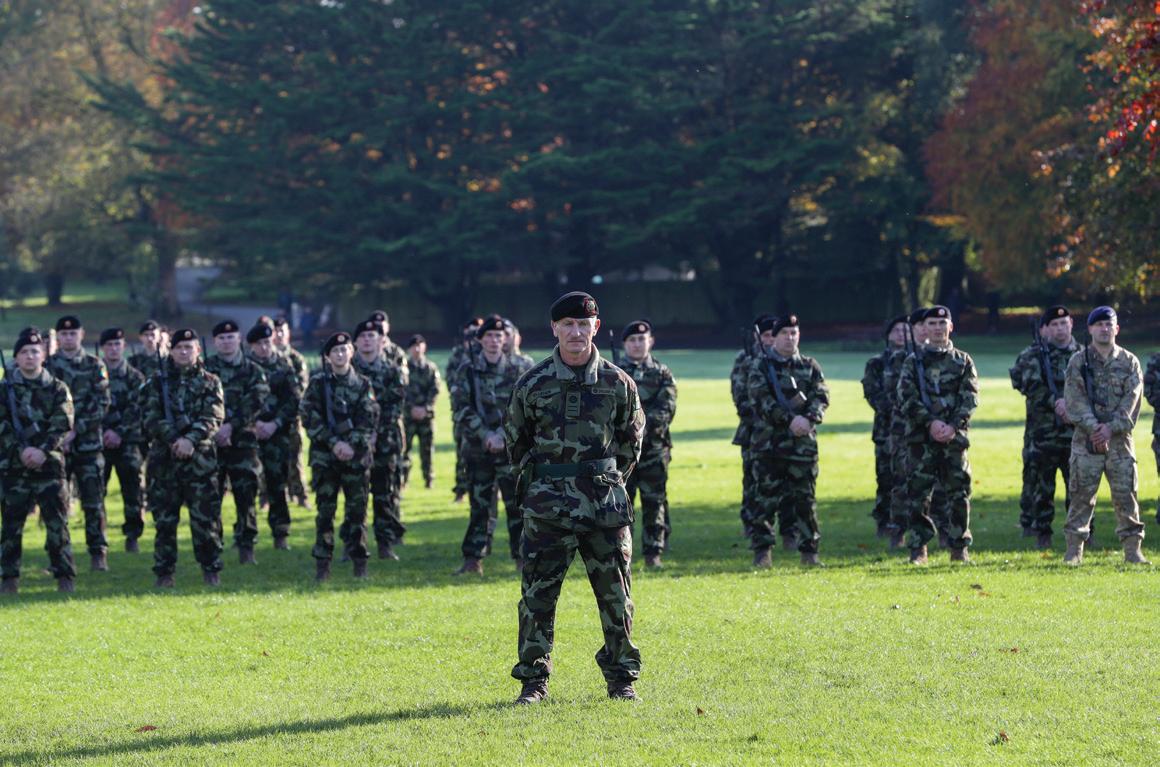
a modern standard of dress, appearance and deportment, aligning Defence Forces practices with contemporary societal norms while maintaining military discipline”.
A notable update was that whereas female members previously had to have short hair or wear their hair secured in a bun with a net, they could now choose from six di erent ways to wear it. Females are now also permitted to wear nail varnish, and should they wish to, fake tan, but these must complement the uniform.
Sergeant Major Keith Ca rey, who is tasked with reviewing grooming standards, said the Defence Forces are
making e orts to be as progressive as possible while also keeping health and safety and operational e ectiveness in mind.
Male members, meanwhile, will now be permitted to apply to grow a beard, with a decision based on appearance and operational factors, and strict guidelines on length and style.
It is hoped the new measures will attract more people considering a career with the Defence Forces. Sergeant Major Ca rey said: “ is is about respecting the individual. Allowing them to be themselves but at the same time, regulating to be a military force.”

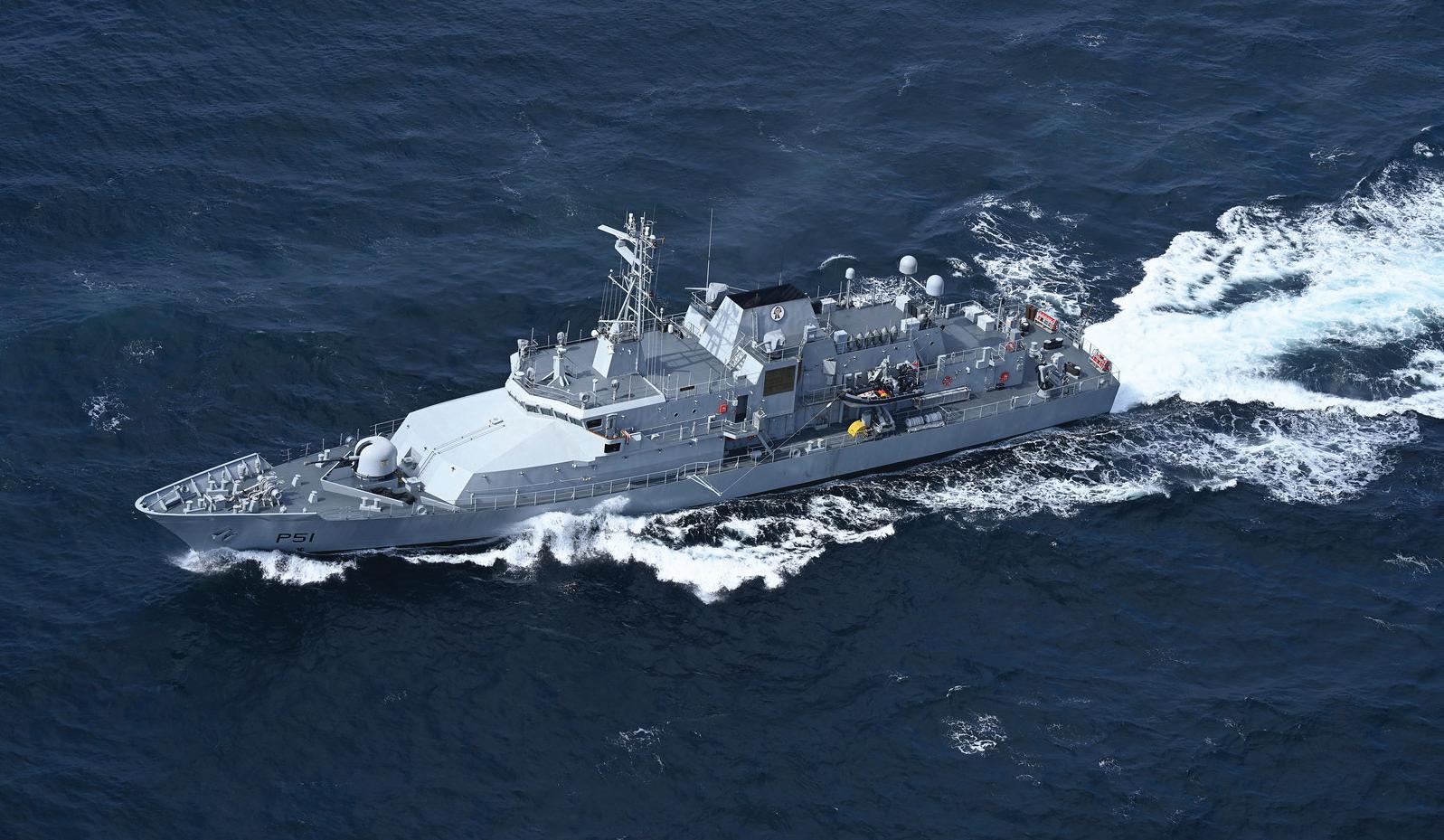
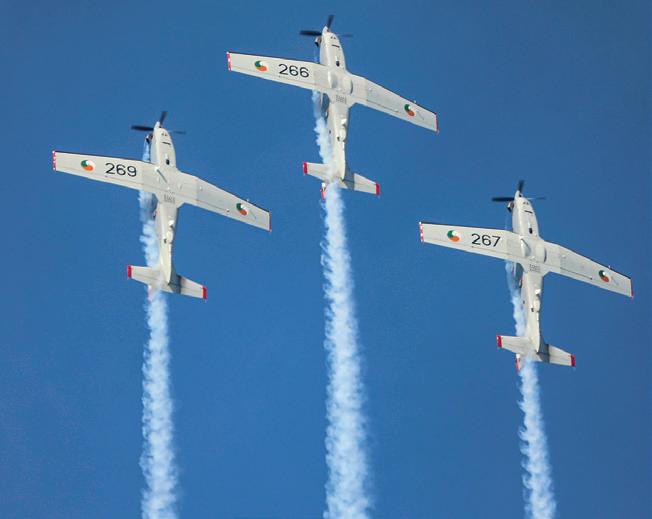



In February, the 123rd Infantry Battalion who deployed to the UNIFIL area of operations in South Lebanon in November with 343 personnel (20 female) for a six-month mission, conducted life-saving rst aid training for locals and delivered essential medical supplies to villages a ected by con ict. Drawn primarily from Stephen’s Barracks, Kilkenny, this Battalion replaced the 122nd Battalion who deployed last May, and had 86 soldiers deploying on their rst mission.
March saw another update to Defence
Forces policy, with the mandatory retirement age increased to 60, providing greater job security and improving long-term earnings for personnel. is retirement age would further increase to 62 in August.
April saw the then-Tánaiste busy again as he inspected the 124th Infantry Battalion ahead of their mission to Lebanon. ere were 30 counties represented in the contingency, with 120 personnel deploying on their rst overseas trip. In total, the Battalion was made up of 341 personnel (9 Maltese), and were deployed to rotate with and then replace
the 123rd Infantry Battalion. ey would then commence operations as part of a multinational battalion comprising Irish, Maltese, Polish and Hungarian personnel, collectively referred to as IRISHPOLBLATT, supporting UNIFIL’s mandates in accordance with the UN Security Council.
Back home, in May, two new in-shore patrol vessels, the LÉ Aoibhinn and the LÉ Gobnait were o cially named, marking signi cant progress for the Naval Service’s operational capacity. e vessels, which were purchased from the New Zealand government in 2022, underwent a programme of works and preparation at the Naval Base in Haulbowline, Co Cork, with crew familiarisation and training completed before they became operational.
e Department of Defence said in a statement that the purchase of the vessels was one of “several strategic measures” being implemented by the Government to increase the capabilities of the Naval Service in the Irish Exclusive Economic Zone.
“ e IPVs will be tasked like all other operational vessels with a variety of defence and other roles. While the main daily tasking will be to provide a shery protection service in accordance with our obligations as a member of the EU, they will also carry out a number of other non- shery related tasks in tandem with maritime surveillance.”
Also in May, Lieutenant General Seán Clancy was elected the Chair of the EU Military Committee, the EU’s highest military body, solidifying Ireland’s voice in European defence and security. It is the rst time Ireland has chaired the Committee.
e EUMC is composed of the chiefs of defence of the 27 member states, who are regularly represented by their permanent military representatives, and is the forum for military consultation and cooperation between the EU member states in the eld of con ict prevention and crisis management.
It directs all military activities within the EU framework, in particular
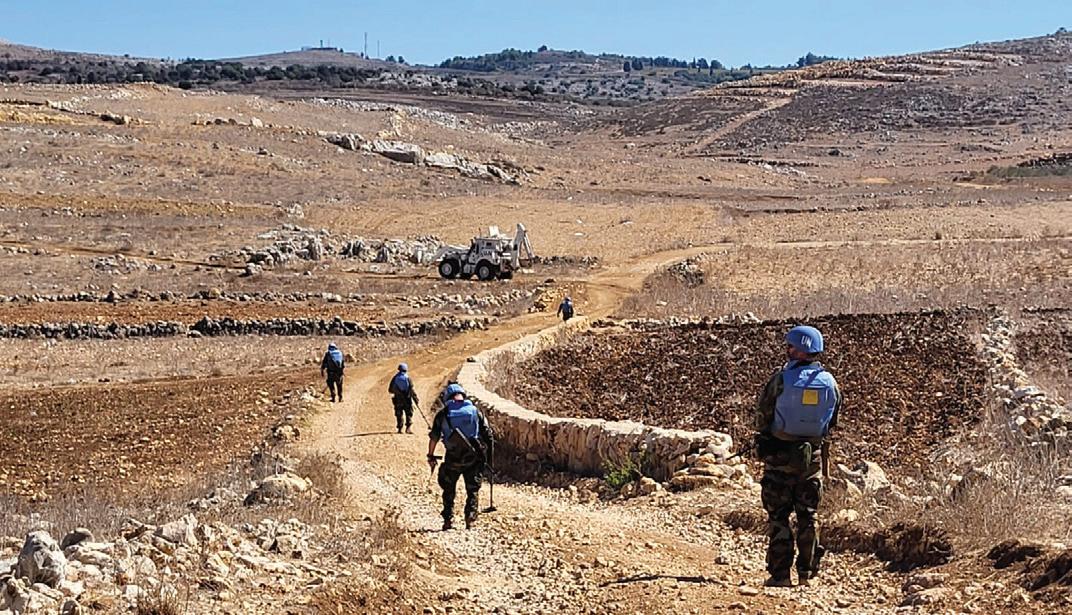

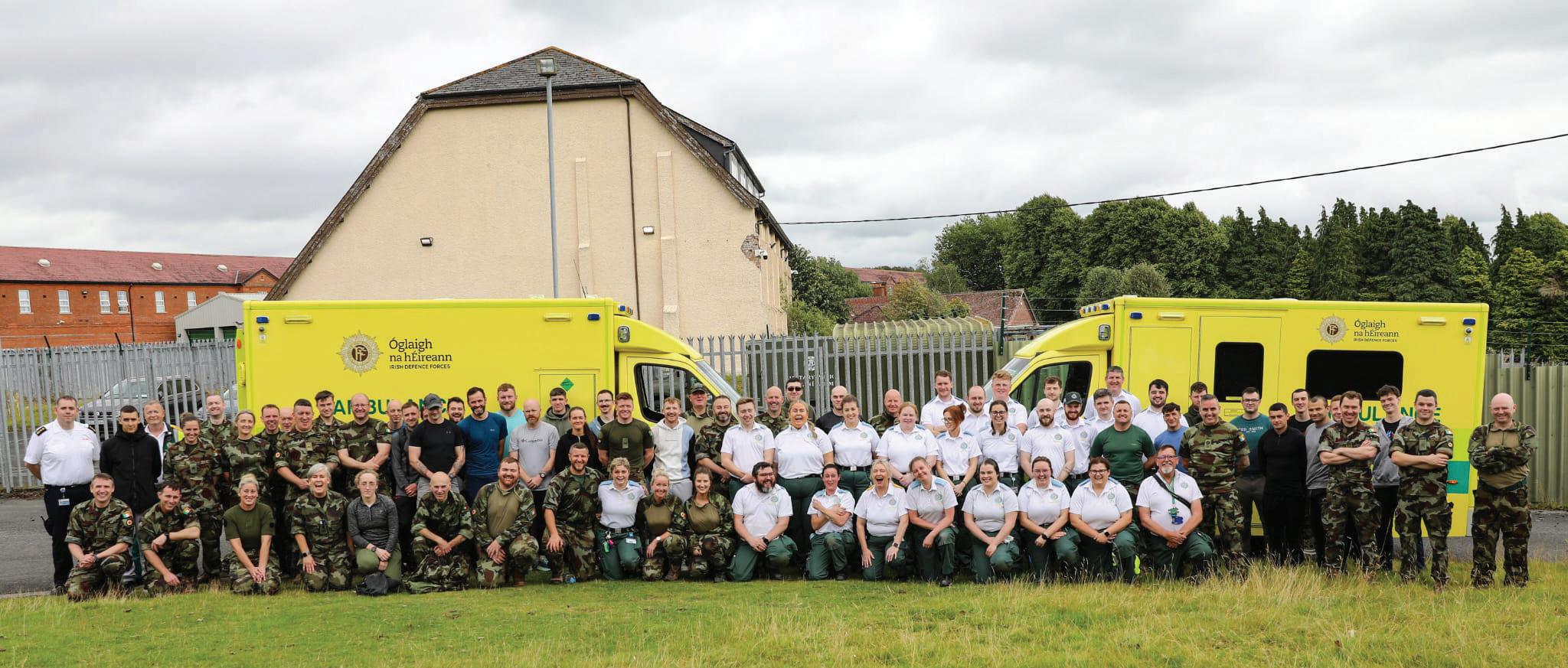
The Central Medical Unit continued to make news in June, when they became the first Irish team to win the International British Army competition exercise Arduous Serpent”
the planning and execution of military missions and operations under the Common Security and Defence Policy and the development of military capabilities.
Lieutenant General Clancy was promoted to the rank of a four-star general, the highest grade any military o cer has had in a century.
en-Tánaiste and Minister for Defence Micheál Martin said he warmly welcomed Lieut Gen Clancy’s election at a crucial time for Europe, with increased regional and global instability and insecurity.
“He brings with him almost 40 years of distinguished military service with the Irish Defence Forces,” Mr Martin said, acknowledging Lieut Gen Clancy’s range of defence experience and his skills in partnership building. “He is ideally suited to apply his abilities to
the role of chair of the EUMC at such a crucial time for the military pillar of the EU’s Common Security and defence policy.”
Still in May, Private Nicole Carroll from the Central Medical Unit, received the Dara Fitzpatrick Award for embodying values such as compassion, bravery, teamwork and professionalism. Based in the Curragh Camp where she cares for 1,200 soldiers, Private Carroll is a combat medical technician. She is from a military family, with her father and three brothers also serving in the Defence Forces, but has forged her own path to becoming widely known and highly respected among her peers. Now in its second year, the award presentation served to remember the legacy of Dara Fitzpatrick, an Irish Coast Guard Search and Rescue pilot, by celebrating inspirational women
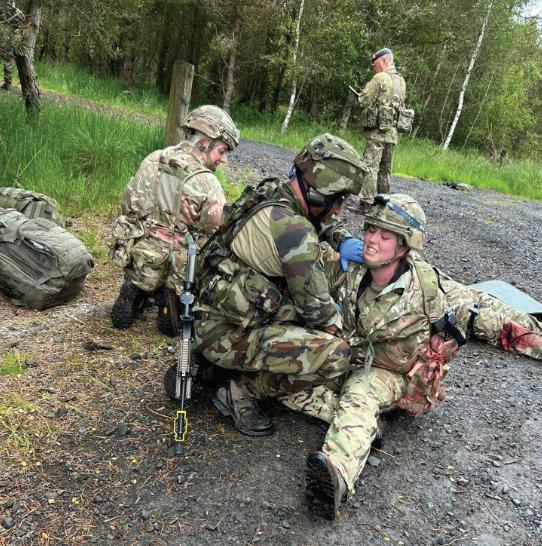
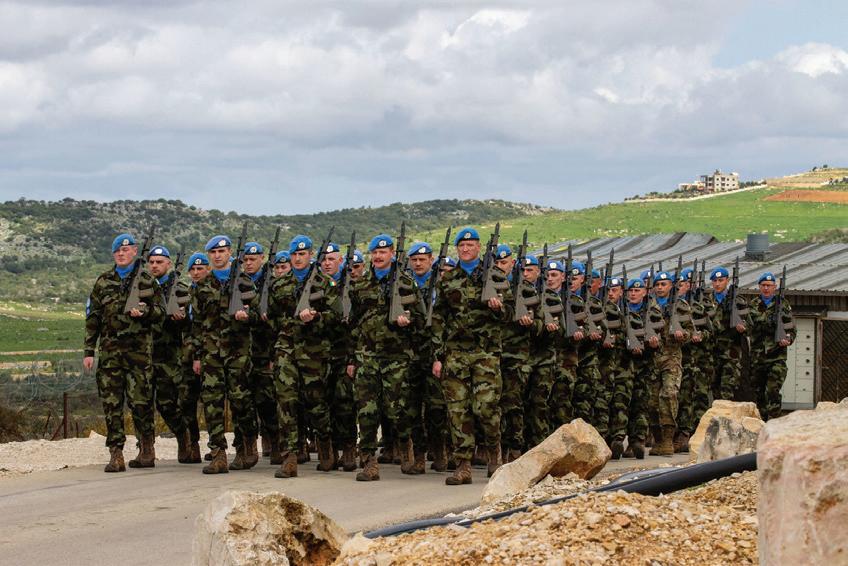

who work in Ireland’s pre-hospital community and emergency services. e award was presented to Nicole at the ceremony by Dara’s sister Emer Fitzpatrick.
Private Carroll was a member of the medical section with the 121st Battalion in the Lebanon during a very tense period from November 2022 to May 2023. is was her rst tour of duty with the UN, and despite being a junior member of the battalion, conducted herself in a manner of outstanding professionalism. In the performance of her duties, she upheld the highest standards and demonstrated great strength and ability.
Also in May, the Air Corp Emergency Aeromedical Service marked its 6,000th lifesaving mission since its inception in 2012, while the LÉ Aoibhinn embarked on its initial operational trials.

e Central Medical Unit continued to make news in June, when they became the rst Irish team to win the International British Army competition exercise Arduous Serpent, outperforming global military teams and showcasing elite operational readiness.
Held over an intense 14-hour period, the competition is designed to test the capabilities and readiness of Military Medical Units through a series of challenging scenarios. It consisted of eight demanding exercises designed to test various aspects of military skills and medical pro ciency while also testing physical and mental endurance: triage; counter-unmanned aerial surveillance; advance to contact; recognition of armoured ghting vehicles; anti-ambush drills; medicate & evacuate; digging techniques; and chemical, biological, radiological and nuclear threats.
In July, the Defence Forces Transport Corp completed a 3,600km mission to deliver vehicles to Ukraine’s border, including ambulances, to aid frontline operations, meaning 30 Irish Army vehicles are now being used on the frontline of the Ukrainian war, acting as ambulances and carrying supplies. Dubbed Operation Carousel, the convo travelled to France and across Belgium, the Netherlands, Germany and Poland to reach the city of Rzeszow, where Ukraine representatives received the vehicles.
Back home, families of Defence Forces members enjoyed a dedicated day of appreciation at Dublin Zoo to acknowledge their vital support for loved ones on the frontline overseas.
In August, over 100 personnel took part in Exercise Cúchulainn, a multi-agency mass casualty incident exercise aimed at strengthening collaboration between Defence Forces paramedics, the HSE and the NAS, as well as the Army Reserve, Air Corps, Ordnance Corps and Civil Defence, based on the London Bridge terror attack in 2017, and was replicated on the ground in the Defence Forces Training Camp at the Curragh.
September saw the LÉ James Joyce participate in maritime exercises with NATO Standing Maritime Group 1, to enhance international knowledge-sharing and cooperation. Ships assigned to this Group conducted a Passing Exercise and medical team exchange with the Irish ship to continue NATO’s tradition of interoperability with Allies and partners.
e Defence Forces Infantry Tactical Competition that tests tactical pro ciency in challenging conditions also took place in September in the Glen of Imaal. It was conducted over two days, with the rst focusing on infantry skills and the second on ri e and pistol shooting. 1 CN COIS were the eventual winners.
In October, Operation Fág an Bealach ensured critical supply routes to Irish peacekeeping posts in Lebanon were secured safely amidst turbulent times in the region. is multi-phase operation was meticulously planned with the force protection of soldiers a priority, and a broad spectrum of skills and capabilities within the 124th Infantry Battalion were utilised to ensure safety and mission success.
Almost 800 personnel also took part in the Cosantóir 10k race in September, with new race categories and top performances from Defence Forces personnel and teams seen on the day.
e Air Corp’s Pilatus PC9M aircra also marked 20 years of operational excellence in October, with a ceremony celebrated by instructors, technicians and international guests including the RAF, and French and Slovenian Air Forces.
New combat clothing systems began trials in November, with two systems rigorously tested under operational and climate conditions.
Meanwhile, the 124th Infantry Battalion returned home a er their six-month mission to Lebanon, while the 125th Infantry Battalion began their deployment.
e Defence Forces Remembrance Ceremony was also held at the National Memorial Square to remember the nine
members who lost their lives in the past year. As part of the ceremony, the Tánaiste and Minister for Defence and families of the deceased members laid wreaths.
e Defence Forces Values Champions ceremony also took place, with guest of honour Niall Quinn and Chief of Sta Lieutenant General Seán Clancy presenting awards to eight exceptional recipients. Awards went to Paul Jordan, Fr Dan McCarthy, Deirdre O’Raw, Eoin Coughlan, Seán Dineen, Dylan Cadogan, Mark Barker and Alan O’Reilly.
In December, the Irish contingency of the EU Battlegroup took part in MILEX24, the EU Crisis Management Military Live Exercise, in Germany. ey provided a Force Protection Company during an intensive Command Post Exercise and conducted Live Fire Tactical Training up to Mechanised Infantry Company level. e exercise has seen 1,700 military personnel from 17 EU Member States deployed.
MILEX24 aims to evaluate and enhance the interoperability of participating nations’ forces in planning and executing joint operations across strategic, operational, and tactical levels, and Ireland’s involvement underscores its commitment to international cooperation, crisis response, and contribution to enhancing European security and peacekeeping capabilities.
Finally, in December, the Irish Defence Forces joined with An Garda Síochána for a moving ceremony at Ballinamore, Co Leitrim, to unveil a Monument of Remembrance honouring Private Patrick Kelly and Recruit Garda Gary Sheehan for their ultimate sacri ce in the service of the State in 1983.
Both men were part of a joint Irish Defence Forces/Garda search party looking for kidnapped businessman Don Tidey when they were confronted by a Provisional IRA gang at Drumcornan Wood in Ballinamore, and shot dead.
Brigadier General Rossa Mulcahy represented the Irish Defence Forces at the ceremony, alongside Garda Commissioner Drew Harris, Minister of State at the Department of Justice James Browne, and members of the Sheehan and Kelly families.
Recently retired Liam MacGabhann, who was the most senior member of Dublin Fire Brigade, talks to Adam Hyland about his career
In Dublin Fire Brigade, the lower your badge number, the more senior you are within the organisation, and if you hold Badge Number 1, you know that you have had a long and eventful career. is is very true of recently retired Fire ghter/Paramedic and Senior Man Liam MacGabhann, who was happy to share stories from his time with Dublin Fire Brigade as we sat in Tara Street re station on his last night of operational duty before retiring last November. Liam was selected for the rst class to train at the DFB Training Centre in 1985, and says he was eager to start a new career that saw him serve the public from both re appliances and ambulance.
“I was in a job in microelectronics, but it wasn’t my cup of tea,” he tells me, “so I applied for DFB and got on the panel, and was delighted with that. I’d joined the FCA as it was then when I was 14, had to lie about my age, and I always enjoyed the outdoor aspects of that, so I was always in some kind of uniform, I just changed hats! I was 22 then and felt like I was made for life. My father said at the time ‘You are alright now son, you’ve made it’, and I was still there 40 years later. I started in the old Tara Street station, which was everything I thought it was going to be. At that time we worked the Control Room too, and I really enjoyed it.”


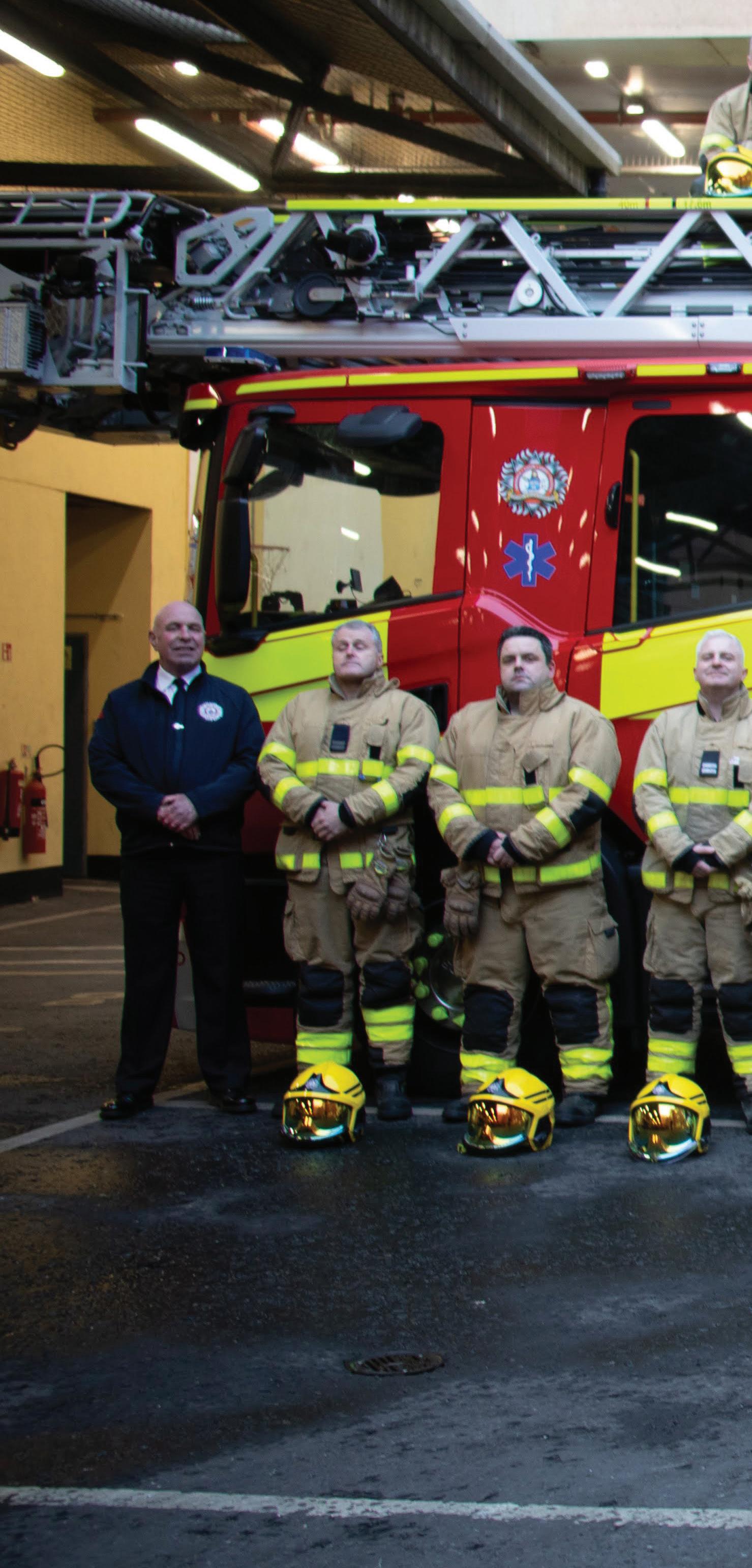

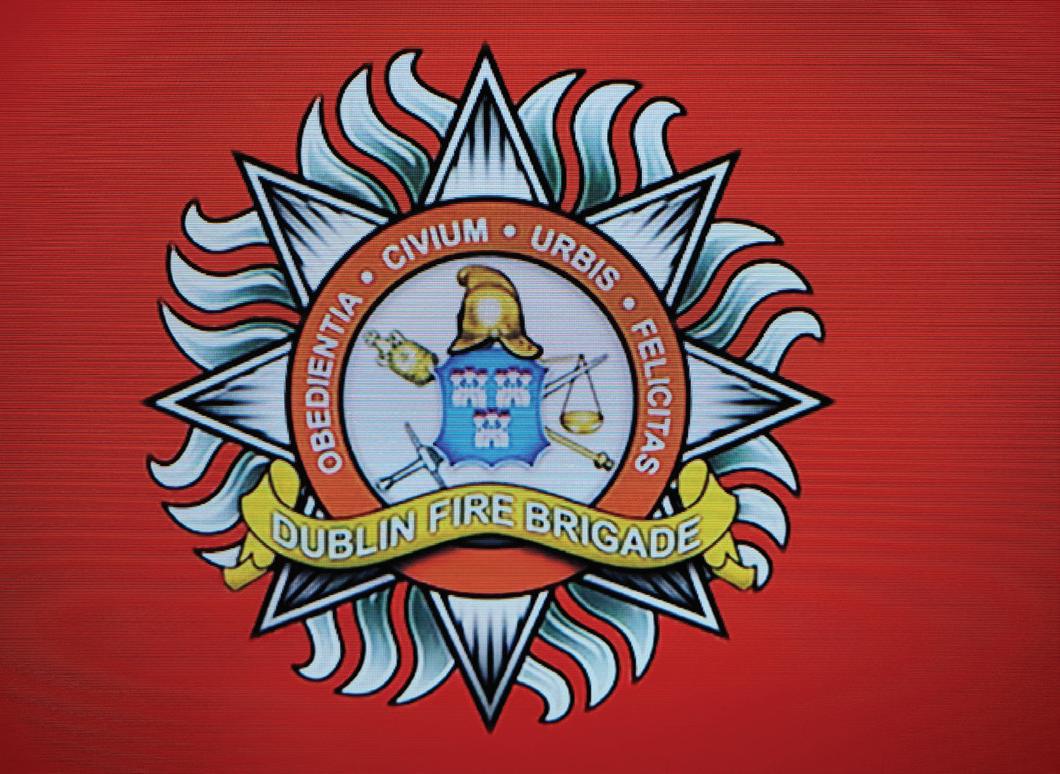
The greatest gi t that I have learned through this whole journey is being able to help somebody who is struggling through a crisis in their lives”

roughout his career, Liam always sought to learn more. Having completed his Ambulance Course in 1986, he went on to do the HGV Driving Course in 1987, completed the rst ever DFB Cardiac Course in 1990, and graduated from a two-year course with the Institution of Fire Engineers in 1992. Later, in 1997, he completed the turntable ladder driving course at the Training Centre.
“When I do something, I always want to do it to the best of my ability,” he tells me as we sit down to talk in the station’s mess hall. “When I was in the Army Reserve, I wanted to do my best at shooting, map reading, etc, and when I joined DFB I had the same drive to do the best I could, so that is why I went and did all of those courses.”
He also enjoyed the sports and social aspect of the job, winning an All-
Ireland re service snooker competition and taking part in a sponsored parachute jump in 1987, which was “something I never would have had the chance to do if I hadn’t been in the job”.
In 1993, Liam was chosen to participate in a European Fire and Rescue Service joint exercise in the Netherlands alongside members of Cork Fire Brigade, and made his rst move out of Tara Street to Rathfarnham re station in 1999.

Many DFB members like to make their mark in their careers, and in Liam’s case, that can be taken literally. Back in 1994, he was asked by then-Chief Fire O cer Gillick to design a new logo and new rank markings for Dublin Fire Brigade, and these are present to this day.
“He asked me to design something with an Irish avour,” Liam says. “ ere is an Irish plant called sempervivum tectorum, also known as reweed, which used to be sewn into peoples’ houses because it a succulent plant that retains water, and if the roof went on re, the last part that would go up in ames would be where the succulents were, so it gave people time to get themselves and their possessions out.
“If you look at the design of the Station O cer pips, you’ll see it as if you are looking directly down onto the plant itself. e District O cer pips have an oak leaf design. e Sub-O cers bars now have a Celtic design on it too. It is nice to think that these designs are still going to be there a er I am gone, on every DFB uniform, appliance and ambulance,” he adds.
Six years later, Liam moved to Dun Laoghaire re station where he stayed for 14 years, and in this time, still with the Army Reserve, he won the All-Army Pistol Competition and took part in the World Police and Fire Games in New York representing DFB in shooting, where he achieved a personal best score in the Individual Pistol event. He also


represented the Army Reserve and Ireland in the Netherlands International Shooting Competition, ranking 8th place internationally.
“On a personal level, that was a big achievement,” he tells me.
Liam then made the move back to Tara Street in 2019 to work in the East Region Control Centre (ERCC), Which handles all re, rescue and emergency calls for Leinster, and all emergency ambulance calls for Dublin city and county.
“I chose to come back to work in the Control Room, for a change of pace,” he tells me. “It was totally di erent when I came back. First time around, it was all pen and paper and writing in the Occurrence Book, but now it was all computerised, so it was a hard task to come back and learn about the computer operating systems.


“ e rst few months, I was full of trepidation because you are taking calls and you know peoples’ lives are on the line. When you turn out for a re you are part of a team, but when you are taking the call, you are responsible for getting as much information as you can in the right amount of time and then dispatch an appliance or ambulance to the call. I was 57 coming in, so I was a late starter, but I did it for four years and really enjoyed it.”
It was at this time that the DFB badge numbers were redone, with Liam gaining the prestige of having Badge Number 1 as the most senior member of the Brigade. For him, it was an honour, but it also had responsibilities.
“You do nd yourself as a role model to other re ghters,” he says. “You have to take that bit of time to consider that as Senior re ghter, how would I

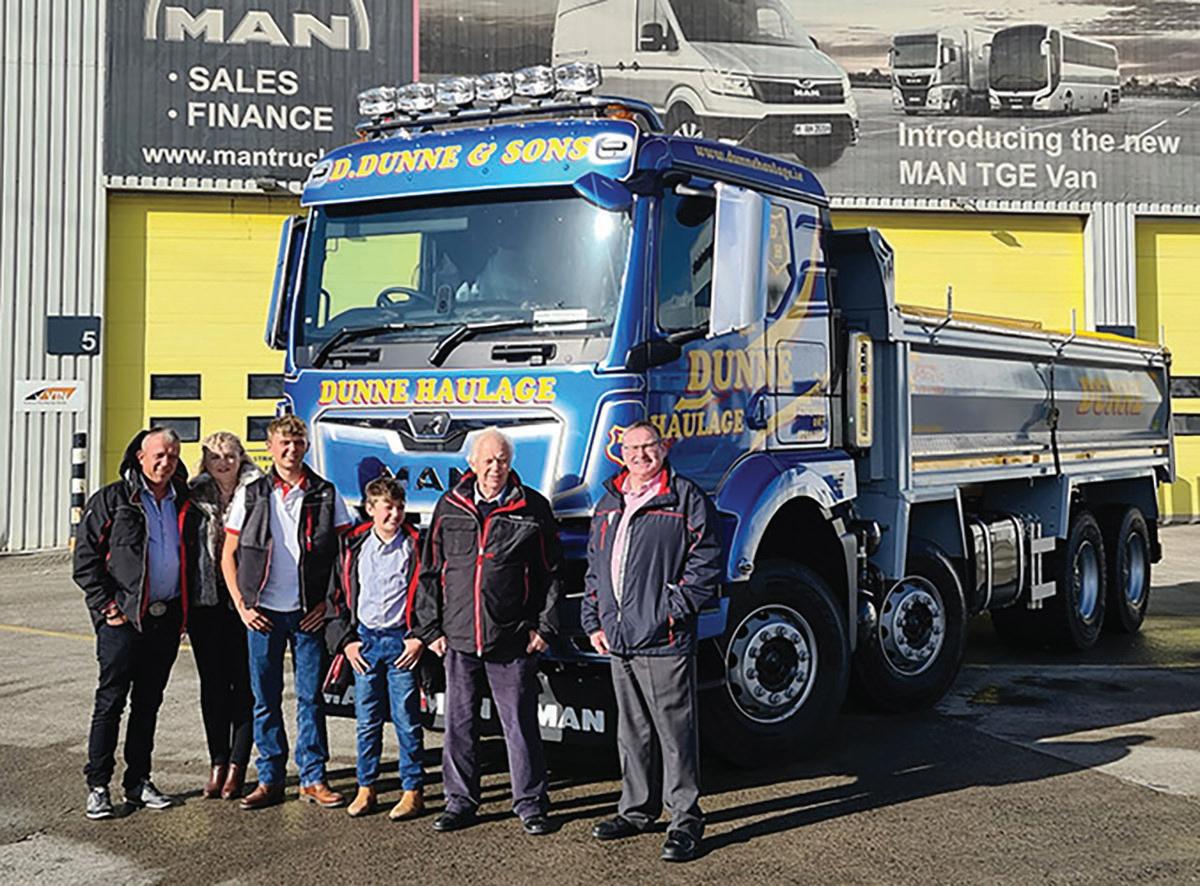
Pluckerstown, Kilmeague, Naas,County Kildare. Tel: 045 845851 Mobile: 087 2707061 / 2866067






















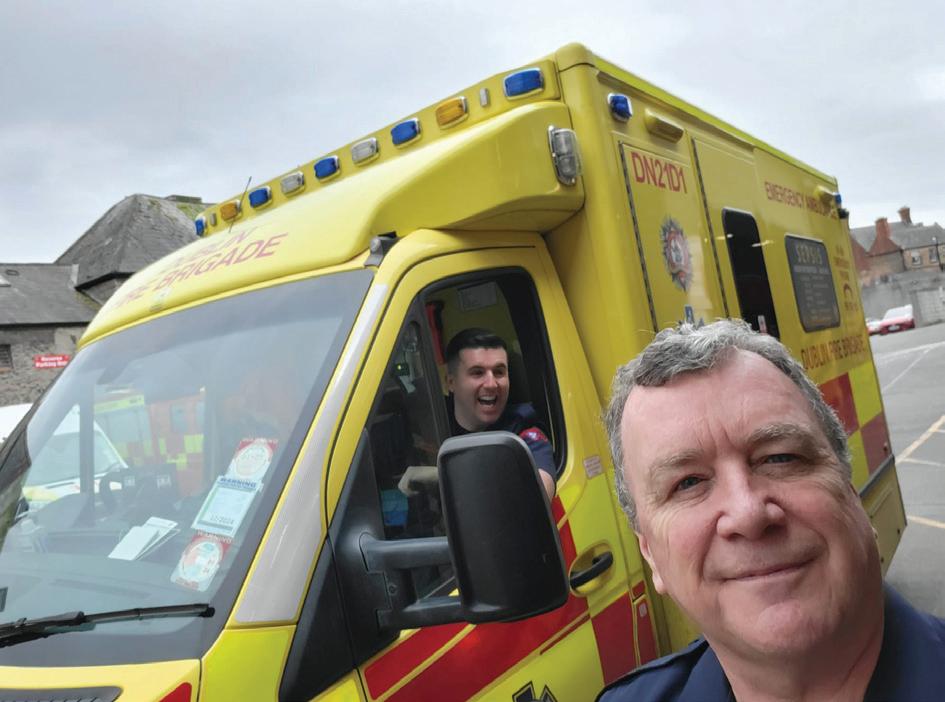
handle this situation? You can still have a laugh, but you have to be mindful of the position you hold.”
A er four years, and with retirement approaching, Liam made the decision to return to operational duty.

“I preferred to go out while operational, because thank goodness I still have my health, and I was still able to do the job,” he says. “It was good to be back on the re and ambulance side of things. It’s the search for something new that interested me, even at that stage of my career. It felt like coming around full circle.”
Looking back, Liam says he has seen signi cant changes in DFB since he rst started. “ e power tools we use nowadays such as the cutting equipment, hydraulic rams, they were only being introduced when I started, and they made a huge di erence over the years,” he says.
On the paramedic side of things, he feels there have been even more changes to the role.
“I went back out to the Training Centre in 2001 to retrain with all the medication that was coming online, and it was a lot to take on,” he says. “When I joined the ambulance was very basic. Now, the paramedic side of the job is essentially a degree course.”
Despite the steep learning curve, Liam says he cherished his time working on the paramedic side of the job.
“I always loved doing the ambulance, right up to the end,” he tells me. “I particularly loved cardiac and childbirth. I delivered 15 babies altogether. I dealt with a lot of cardiac events too. I stopped counting a er three years in the job, but at that stage it was already 18.”
Liam tells me it was always a pleasure to come to work. “As the saying goes, if you get a job you love, you never have

to work a day in your life, and DFB treated me very well,” he says. “It has given me a huge sense of achievement. It is a proud moment when someone asks you what you do and you can say you’re a re ghter/paramedic. You are held in high esteem by being in the service of others because we are the custodians of peoples’ turmoil and torment.”
Liam acknowledges that there have been challenges too, but feels the camaraderie he enjoyed in the job was one of the most appealing aspects of it.
“It is not always plain sailing, and you do come across incidents that stay with you,” he says, “but you have to deal with it because it is part of the job, and on the upside there is the camaraderie you have with your crew. We all deal with things in our own way, but we also deal with it collectively. You need to have a good debrief every now and then if you feel things are getting the better of you. We try to look a er each other, there is support there at the station.
“ e thing I will miss the most is the camaraderie,” he adds. “ e re brigade has given me so much. Even other aspects such as friendship, companionship, the resourcefulness to realise that you can do a lot of great things once you have the right attitude. I have kept that in mind throughout my career. When I rst started working in DFB, a Senior Man said to me: ‘Congratulations, you have got yourself a front row ticket in the Circus of Life’ and that’s very true. In many ways you are a spectator as well as a participant in the circus of life. I’ll miss the clowns, but I won’t miss the circus!”
Given his position as outgoing Badge Number 1, I ask if he has any advice for re ghter/paramedics starting out on their career.
“Young people coming in should look at the job as an apprenticeship,” he tells me, “and do every aspect of the job to become a good all-round re ghter/ paramedic. at way, there is less chance of something happening that you are not familiar with. Focus on every aspect and try to do it to the best of your abilities so you can see the challenges ahead.
“ e most important thing to remember is that you are in the service of others. If you are out there helping somebody who is probably having the worst day of their lives, it starts to improve their life from that moment on. If you can turn that situation around, stop that bleeding or return circulation in a cardiac arrest, get them to hospital and they survive, that is the greatest gi you can give.
“So, if you have an ambition to be good at your job, have the courage to start at the bottom and work through the process. ere you will learn to handle your psychological needs, the highs and lows of your job. Life is a rollercoaster of successes and failures. You can’t save everyone. All you can say is that you did your very best. Success is about growing as a person, surviving the setbacks, enjoying life.
“But the greatest gi that I have learned through this whole journey is being able to help somebody who is struggling through a crisis in their lives, whether that be a cardiac arrest, a domestic re, a road tra c accident or delivering a baby. Using your strength and wisdom in helping others is the ‘Bank Balance’ in life. It’s the best trophy you will ever hold high in your hands.”
As far as retirement goes, Liam says he is looking forward to it.
“I plan to chill out for a while to let it all sink in,” he tells me. “I have a job one day per week driving a tour bus around Dublin, which keeps me active, but I also want to enjoy my retirement with my partner, looking forward to planning a few trips away together. It will be nice to share our interests together. We’ve earned it!”
The Health Service Executive (HSE) published its National Service Plan 2025 in January, setting out a range of health and social care services that will be provided within the allocated budget of €26.9billion.
With a €1.6billion increase in funding on 2024, the new Plan includes a €298million investment in new service developments including enhancing mental health, older people and disability services.
Outgoing Minister for Health Stephen Donnelly said the service plan will be supported by a capital plan involving €1.4billion for infrastructure and equipment across the health service, with €190million of that speci cally earmarked for digital and ICT infrastructure.
Six new health regions have also been established. According to the HSE, health and social care services will be planned and delivered around the speci c needs of local populations, leading to “better co-ordination of care and access to services”.
“ is o ers the opportunity to take the next step in creating a modern, value-based health and social care system. Finalising the change from the traditional operational centre of the HSE to a visible regional operating system overseen from the Centre is a key target. is will mark the completion of the most signi cant structural reform of the HSE and how it operates since the organisation rst came into being,” stated the Executive.

Speaking about the HSE’s priorities in 2025, HSE Chairperson Ciarán Devine said: “ e board’s overarching objectives for 2025 are to support improved e ciency and increased productivity, maintaining the ongoing focus on improving the quality of care, and continuing the shi to providing more care closer to people’s homes.
“While we have seen signi cant progress over the last three years, a priority for the HSE in 2025 will be to further reduce waiting times. We will place a speci c focus on maximising an integrated approach to care delivery across community and acute settings, enabled through our new health regions.”
Mr Bernard Gloster, CEO of the HSE, added: “At a time of unprecedented demand for services we must ensure that our funding delivers more care and services to the people of Ireland, reduces waiting times and improves health outcomes of the population. Our priority
in 2025, therefore, must be a relentless focus on productivity and changed ways of working. Expanding our workforce, improving our buildings, adding new capacity and seeing more people than ever must all be pursued at the same time.
“ e digital opportunities for the health service is one of those changes and a major priority as we face new challenges and ensure we can provide the health service the country needs and deserves. I am delighted that the business case for this national electronic health record is progressing and hope it will conclude to next stage approval in 2025. However, in the meantime there are critical steps along the way to this end, such as achieving a summary care record, HSE patient App and use of technology to develop virtual care. Digital for Care 2030 requires us to now deliver on signi cant steps over each of the next few years.”
The number of people in Ireland who reported their health as being good or very good in 2023 was the highest in the EU, according to the Health in Ireland Key Trends 2024.
Published in February by Minister for Health Jennifer Carroll MacNeill TD, this is the 15th iteration of the study and easy-to-use reference guide to signi cant trends in health and healthcare over the past decade, including population and health status, as well as trends in service provision, highlighting signi cant improvements in health outcomes and challenges to the access of timely and e cient healthcare.
According to the report that covers demographics, population health, hospital and primary care, health sector employment and expenditure, 79.5% of people in Ireland describe their health as good or very good, well above the EU average of 67.7%. Life expectancy in Ireland is also the h highest in the EU at 82.6 years.
ough record levels of funding are being put into providing an e cient healthcare system, the growing population remains a challenge. Since 2015, the population of Ireland has risen by 14.8%, with the over 65s group increasing by 36.5% between 2015 and 2024.
In the same time period, the total number of consultant and nonconsultant hospital doctors employed in the public health service here increased

to 13,772, a 61.3% rise. e number of nurses and midwives also increased, to almost 48,000 (up 34.9% ) between 2015 and 2024.
Comparatively, the Health at a Glance: Europe 2024 report by the Organisation for Economic Cooperation and Development notes that many EU countries are grappling with healthcare workforce shortages. Some 20 EU countries reported a shortage of doctors in 2022 and 2023, while 15 countries reported a shortage of nurses. is contrast highlights Ireland’s proactive measures in expanding its healthcare workforce to meet future demands.
e report also outlines that the mortality rate from cancer fell by 14.7% between 2014 and 2023, the mortality rate from cancer fell by 14.7%, the mortality rate from circulatory system diseases fell by 19.5%, the mortality rate for ischaemic heart disease fell by 27.7%, and the mortality rate from respiratory system diseases fell by 15.4%.
e Government funded 77.4% of total health expenditure in Ireland in 2023, with the proportion paid for either out of pocket or through private health

insurance continuing to fall in recent years.
Upon publication of the report, Minister Carroll MacNeill said: “Our population is growing, and we are living longer, healthier lives. With our average life expectancy now at 82.6 years, the h highest in the EU, we need to continue to focus on the future demands for health care. e Key Trends report shows our health service is one that continues to deliver better results for the people of Ireland, in some cases among the best in Europe.
“We are in the midst of the greatest expansion in the Irish health service in the history of the State. Spending on health has almost doubled between 2014 and 2023, and this is re ected in the enhanced availability of services all over the country, and in improved outcomes for many health conditions.
“ e information contained in Key Trends is very useful in helping us to monitor the impact of our policies which protect and promote the health of the nation, as well as to keep focused on making improvements as we plan for the future.”

Many first responders will be familiar with the Dublin Fire Brigade Training Centre in Marino, having passed through its doors for firefighting or paramedic training since 1985, or for further professional development. However, the Centre’s innovation and expansion has continued, with new features recently introduced that may not have been seen before.
Since Dublin Fire Brigade took custodianship of the site in 1985, the Training Centre has seen continuous
development, becoming an innovative hub for training and excellence for re ghters, rescue technicians and paramedics. It now boasts eight teaching areas, including the Chapel Auditorium. e building is managed by Brigade Training O cer (BTO) Brendan Carroll, along with an Assistant Brigade Training O cer, an EMS Training Coordinator, and support sta . is team ensures the smooth operation of numerous courses and events each year, even in the most challenging of times.
“During COVID-19, we were the only third-level institution in Ireland to
remain open,” BTO Carroll says. “We ran a class of 48 recruits and the largest ever paramedic class in the State – 56 students. We complied with all social distancing rules, working in syndicates of seven, and we only had one case of COVID-19, which was immediately isolated. It was a fantastic achievement.”
e Training Centre delivers a wide range of courses to enhance operational skills across Brigades.
“ e Centre o ers the recruit course for basic re ghting skills, along with

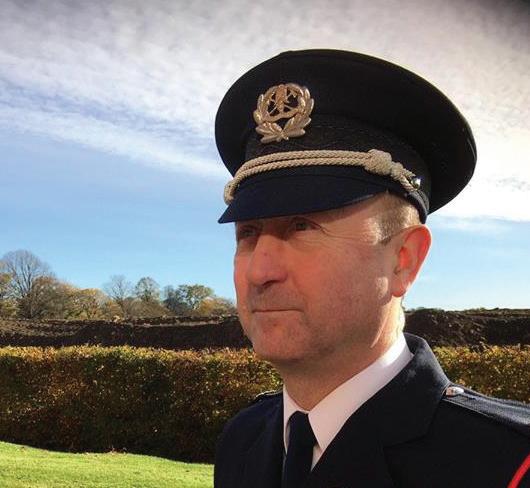

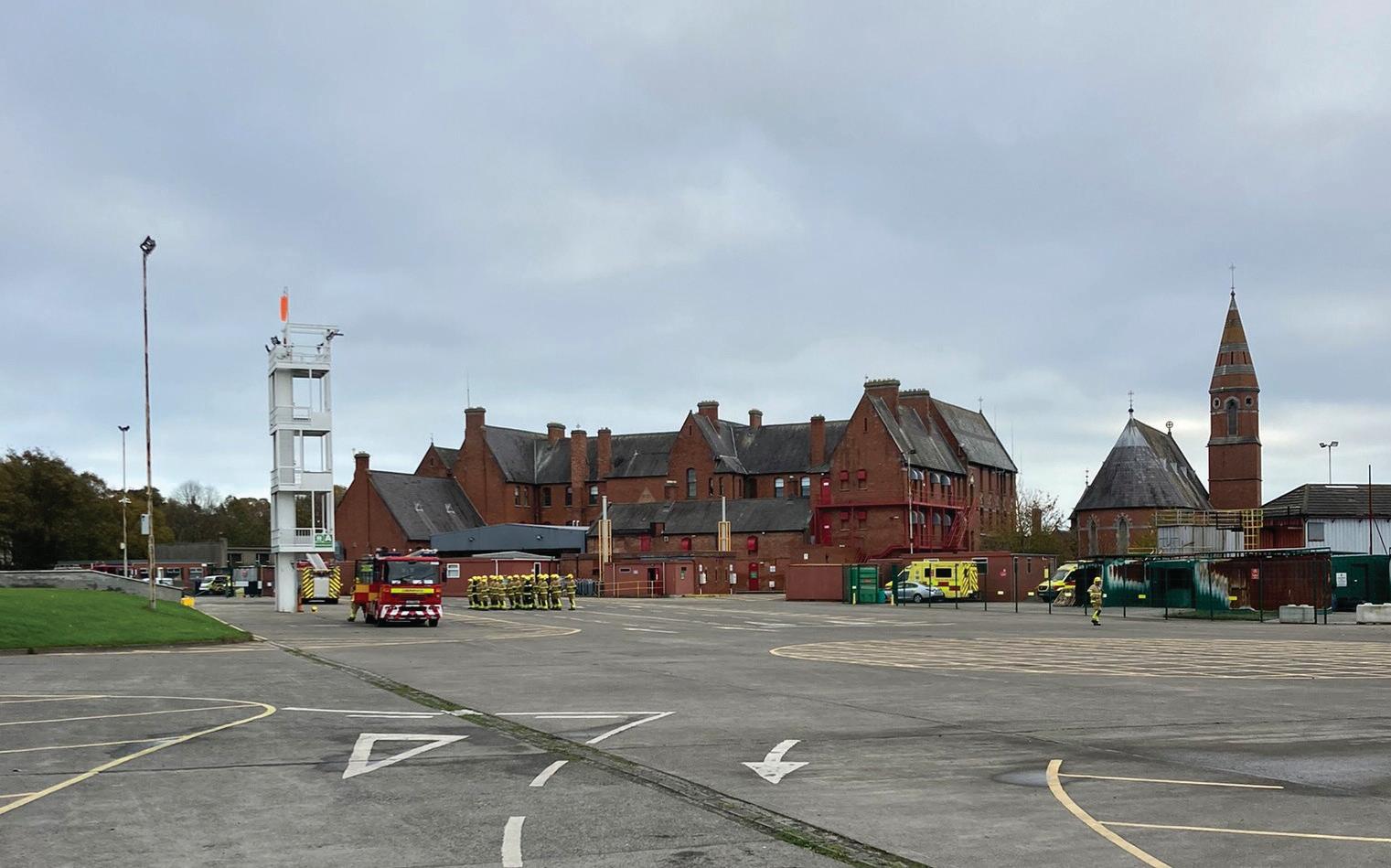
BA, Hazardous Materials, Road Tra c Collisions, wildland res, high-rise re and rescue, strength and conditioning, tunnel operations, swi water rescue, ood rescue, and Para medicine,” explains BTO Carroll. “Additionally, we run continuous medical CPGs to ensure paramedics comply with all new practices and procedures, and BA training integrated with tall and complex building training and emergency and standard basic driving courses.”
Other courses include heavy vehicle rescue, rope rescue, water tanker and winch operations, vehicle-mounted
cranes, high-volume pumps, and advanced pump operations, as well as training on foam tenders, tunnel rescue, and marine emergency response.
“DFB Retained Fire ghters also complete their training at the centre,”
BTO Carroll notes. “In the past year, the centre has trained nearly full time 100 recruits, and this year, another 70 recruits have completed their training. Additionally, we run development courses for District O cers, Station O cers, and Sub-O cers to support newly promoted personnel.”

Specialist courses are taught by experienced DFB instructors who bring their expertise to the class, and all are themselves trained in how to deliver the curriculum.
“On completion of any particular instructor course, a trainee instructor will work with mentors for two courses before becoming a fully quali ed instructor,” BTO Carroll says.
A DFB member for 42 years, he took on the role of Assistant Brigade Training O cer in 2017 and became BTO in 2018. On my visit, he o ers me a detailed tour of the facilities.

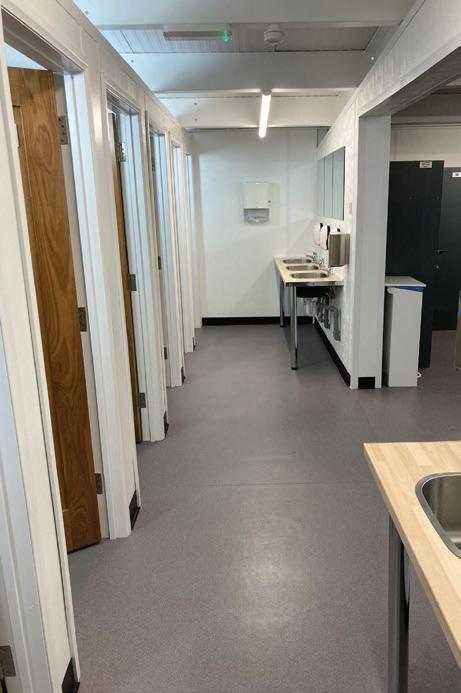
e main building houses several key areas, including the Emergency Response Coordination Centre (ERCC) Training Room, which has its own independent power supply and serves as a standby control room, which was used as the main Control Room for emergency call takers during the pandemic.
e DFB museum is located on the second oor, as are the main classrooms, which are equipped with high- delity mannequins for paramedic training.
“ ese mannequins are incredibly lifelike,” says Fire ghter and Advanced Paramedic Eithne Scully. “ ey can simulate breathing sounds, pulses, and injuries like pneumothorax. You can also monitor vital signs like blood pressure in real-time.”
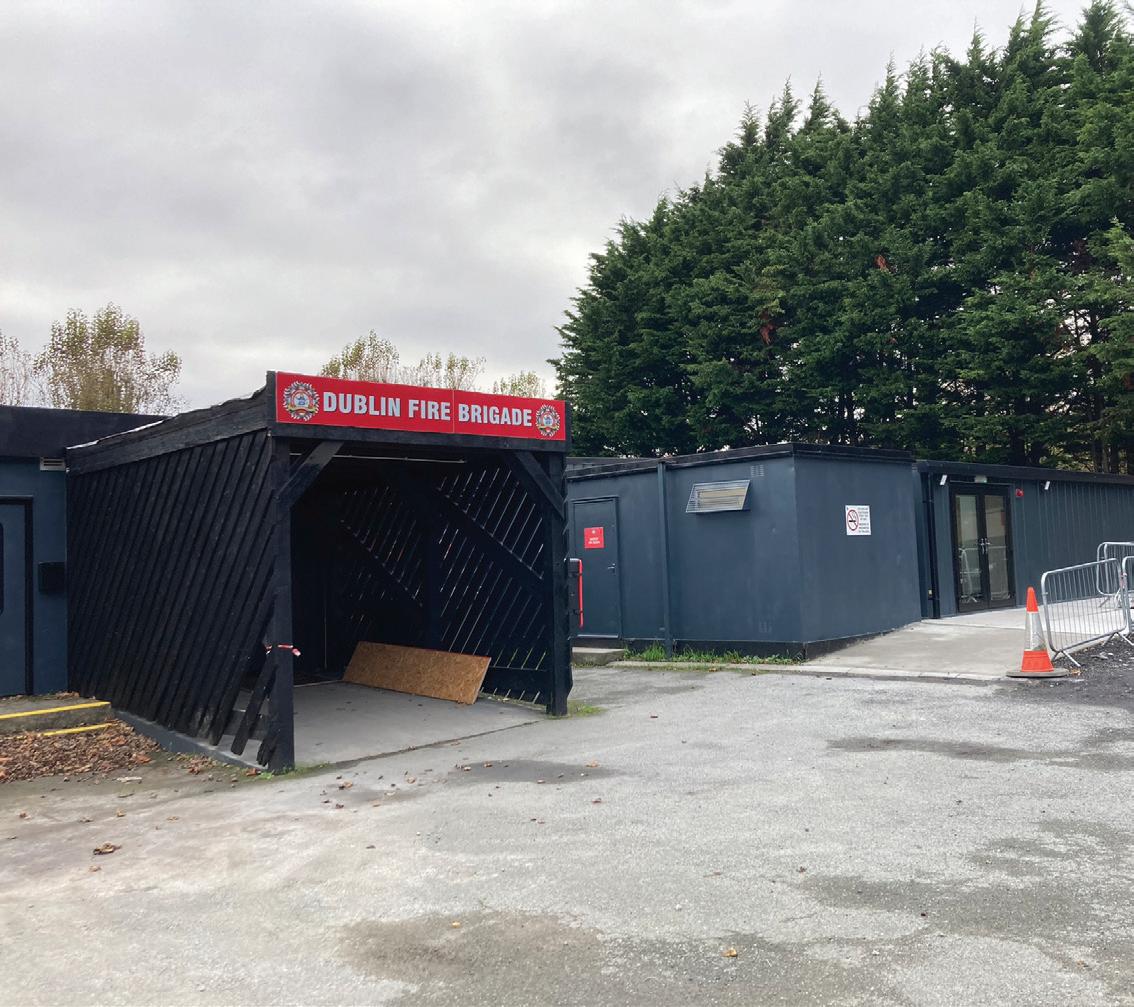

e ground oor contains the Chapel, Classrooms 1, 2 and 3, canteen, various sta o ces, a Conference Room for strategic planning, and the newly renovated BA Work Room 1.
e highlight is the new Virtual Reality Incident Command Training Suite, which is situated on the top oor, designed for Incident Command Training for all grades. is investment enables O cers and re ghters to simulate and manage incidents, with Instructors monitoring the progress in real-time.
BTO Carroll highlights the practical bene ts of the Incident Command Suite, explaining: “O cers can train on incidents of varying scales, from small to large, within an immersive VR environment that enhances the realism of each scenario. Similarly, the

forthcoming ambulance training facility, located on the incident training ground, will enable the rescue of casualties from various scenarios while simultaneously conducting medical interventions. is facility will also simulate patient transport to a de nitive care facility, followed by a patient handover. All these activities can be monitored remotely via CCTV, ensuring a comprehensive and e ective training experience.”
e Brigade has made signi cant investments in its facilities, including the Learning and Development section, which oversees and manages all training materials, ensuring a structured learning pathway. Additionally, an e-learning platform is maintained and managed by



the e-learning team.
BTO Carroll outlines other site improvements, such as the upgraded Stores with an asset management system that tracks equipment, reducing reliance on external logistics. e Brigade vehicle park, BA Training School, RTC training area, and a new foam training area, developed in partnership with the Environmental Protection Agency, have all been added.
“ e ship training facility was recently demolished,” says BTO Carroll, “and the Brigade is currently seeking a contractor to design and build a new ship and port training facility.”
A newly developed recruit area now accommodates up to 60 recruits, both



male and female. e previous recruit area, which holds 30, is reserved for Paramedic or O cer Development courses when demand on the Centre is high.
“ is new facility o ers more space for recruits and includes locker rooms, drying rooms, and muster areas, as well as a kitchen and dedicated downtime space, providing recruits with a space to relax between training sessions,” explains BTO Carroll. “Further plans are underway to improve facilities for female personnel.
“ is downtime area is essential for recruit welfare,” explains BTO Carroll. “While recruits have limited free time when going through their training, it’s important to o er them a space to unwind, eat, or socialise before or a er

training. Our goal is to ensure they have the best possible learning experience.”
As the new recruits rush to change into PPE for their next session, it’s clear that the training facilities at the Dublin Fire Brigade Training Centre continue to evolve, ensuring that Dublin Fire Brigade remains at the forefront of emergency service training.
The Health Service Executive has launched the new HSE Health App that will enable patents to gain easy and secure access to their health information and manage their healthcare digitally for the rst time. Serving as a “digital front door for patients to navigate the health service”, the app can be downloaded for free from Google Play or the App Store by anyone over the age of 16. e rst version is in English, but Irish and other languages will be available in the near future.
Given the sensitivity of healthcare records, it is built with high standards of security and privacy to ensure patients’ personal health information is protected, and is designed to provide a simple and secure way for patients to view their personal health information and have control over their health management, while also o ering access to information sources such as HSE Live. To ensure the highest level of authenticity and security, all users must have a MyGov Identi cation to log in and access their records.
e rst release of the app includes functionality that allows people to carry a digital list of all self-declared medications and see a list of medicines received through the Drugs Payment Scheme or Medical Card Scheme, and store European Health Insurance Card (EHIC), Medical Card, Long-term Illness (LTI), Drugs Payment Scheme and GP Visit cards.
The HSE Has Launched a New Healthcare App Enabling Patients to Manage Their Health Via Their Phone

Users can also access u and COVID-19 vaccination records, nd information about HSE services such as Emergency Departments and Injury Units, and view maternity service appointments.
Speaking at the launch of the app, Minister for Health Jennifer Carroll MacNeill, said: “Today marks an exciting milestone in our journey to digitise patient health records with the launch of the rst version of our new HSE Health App, where we begin to give patients digital access to their own health information and make it easier to navigate the health service.
“We can now ensure that every patient is provided with easily accessible health information that is accurate and trustworthy. e phased introduction of appointment noti cations and reminders will make it easier for people to manage their care. e HSE is working with colleagues across Government to integrate the HSE Health App with the Government Digital Wallet that will be released later this year.”
HSE CEO Bernard Gloster said the launch of the app was another step forward in improving access to healthcare in Ireland.
“ ere has been much progress made in modernising the data capabilities and digital technologies of our health service in recent years,” he said. “ e launch of the rst version of the HSE Health App represents the next step forward in our digital transformation journey, as we seek to harness the power of data and innovation to help improve access to care for patients and enhance e ciencies. We see a future where our patients and the people who care for them are empowered and better informed about their care.
“I will continue to ensure that we prioritise providing increased access for patients to their data and to interact with our health services to improve their experiences.”
HSE Chief Technology and Transformation O cer, Damien McCallion, echoed this, saying: “ is is just the beginning - the app is an evolving programme of work, with new
services and features planned each year, including expanding the appointment functionality for all public hospital appointments.
“ e app is one aspect of the digitisation of the health service and a major priority as we face new challenges and ensure we can provide the health service the country needs and deserves.”
Further planned releases on the app this year will enable users to access public hospital and screening appointments information for public patients, check referrals and waiting times information, and receive additional self-care information and support services, including quitting smoking and chronic disease management. ese future features are guided by ongoing research and engagement with patients, sta and the public, in line with the work already done by the app development team. e HSE consulted with a number of organisations representing disabled people and worked with a Patient Advisory Group to understand the needs of a wide range of people when designing the HSE Health App. It has also been tested with users who rely on assistive technology, and audited to ensure it reaches HSE and European standards for accessibility.
People with accessibility needs will also be able to choose if they want a family member, carer or other trusted person to help them manage their healthcare through the app as soon as the National Shared Care Record is rolled out this year.
Although designed to provide digital management of healthcare for everybody in Ireland, the HSE says the functionality of the rst iteration of the app will be most useful for expectant mothers.
With this in mind, the app was rst piloted in Cork University Maternity Hospital (CUMH) last year, where it was met with positive feedback from both patients and sta . Claire O’Halloran, Assistant Director of Midwifery at the hospital, praised how the app empowered people.

“What I really liked about the app was how it gave women direct access to their own healthcare information in a way that was clear, simple, and easy to understand,” she said. “Expectant mothers at CUMH could track their appointments and get updates about their pregnancy journey, which enabled them to take an active role in their care. I believe it will also improve communication between patients and sta . If women feel more informed and con dent, it will make our conversations more productive.”
Patients were also quick to praise it. Líosa Horgan said the appointments tab was very helpful, adding: “It is handy to have a one stop shop of appointments and information. Everything in one place from the HSE, a good and veri ed source.”
Helene Troissant, meanwhile, found having everything in one secure place was very helpful. “If you lose your appointment card it’s not a problem everything is written down on the app,” she said. “I also had a list of medicine I was taking, which was handy as I can never remember them. Data security and privacy is very important to me as I work in this area in the technology industry. e app to me felt very secure, you access through a ngerprint and through your MyGov ID.”
THE LATEST INNOVATIONS FOR THE WORLD’S EMERGENCY SERVICES

Emergency equipment specialist Dräger has released the PSS AirBoss, their next generation self-contained breathing apparatus, complete with a Type 4 nano cylinder. The company says their kit combines best-in-class ergonomics and an ultra-light design for optimal firefighter comfort, enabling users to breathe more easily and for longer. Features include height adjustment, a pivoting and sliding waist belt, and an easily adjustable harness, while the durable frame design o ers a low weight and profile that maintains optimum centre of gravity. The PSS AirBoss also o ers di erent routing options for the LDV, gauge and rescue hoses while the easy to connect reducer handwheel simplifies cylinder removal and fitting. The kit is equipped with a data logger that automatically logs alerts, air pressure and battery status and has a Bluetooth interface connectivity. The AirBoss is available in three configurations: Active, with a mechanical gauge; Agile, with an integrated PASS device for increased safety; and Connect, with advanced sensors.
Fire safety supplier CheckFire has launched their Commander Wireless Site Alarm following the successful release of their original push-button Single Site Alarm last year. e new wireless model o ers enhanced connectivity, allowing up to 20 units to be linked within a 100-metre range in open air and without obstructions. e alarm features a 105dB siren and ashing LED strobe, ensuring alerts are heard and seen even in the noisiest and most challenging environments, and is manufactured from robust ABS plastic, making it both tough and water-resistant. Toria Jones of CheckFire says: “ is innovation not only enhances connectivity and coverage but also reinforces our commitment to protecting people and property across diverse industries. It’s a robust, reliable solution tailored to meet evolving needs.”
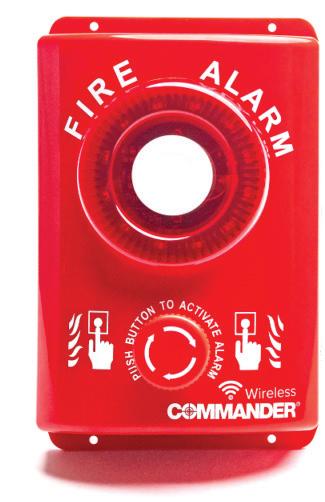
New Horizon Aircraft hopes to transform air ambulance use dramatically with its new hybrid electric vertical takeo and landing (eVTOL) aircraft. The company says the craft, if licensed for commercial use, will reduce transfer times for patients and cutting costs for operators. With a flight range of up to 800 kilometres with fuel reserves, it can cover all of Ireland using existing helipads and analysis shows they are up to two-times faster, 50% more cost e icient, and have almost twice the range of twin-engine helicopters. Data shows a 230 km transfer from Letterkenny University Hospital to Dublin Hospital would take 35 minutes in the Cavorite X7, compared with nearly an hour in a helicopter. The company is designing the Cavorite X7 to re-charge its batteries enroute.

ATOR Labs in the US has launched OMNIcheck, the world’s first breathing machine compliant with NFPA 1981, NFPA 1852 and ISO 16900 standards, which they hope will transform testing protocols for fire departments and training facilities worldwide through its annual SCBA flow tests. With an intuitive software interface, the OMNIcheck allows users to e iciently recertify life support equipment while adhering to OSHA 1910.134 record-keeping requirements. In the US, it is already providing NFPA 1852-compliant flow testing, comparing life support equipment performance against established standards to support robust respiratory protection programs. Internationally, users across Europe, Africa, and Australia can input local testing requirements for any SCBA model into OMNIcheck’s versatile software, with all data and test reports easily accessible from a native database.
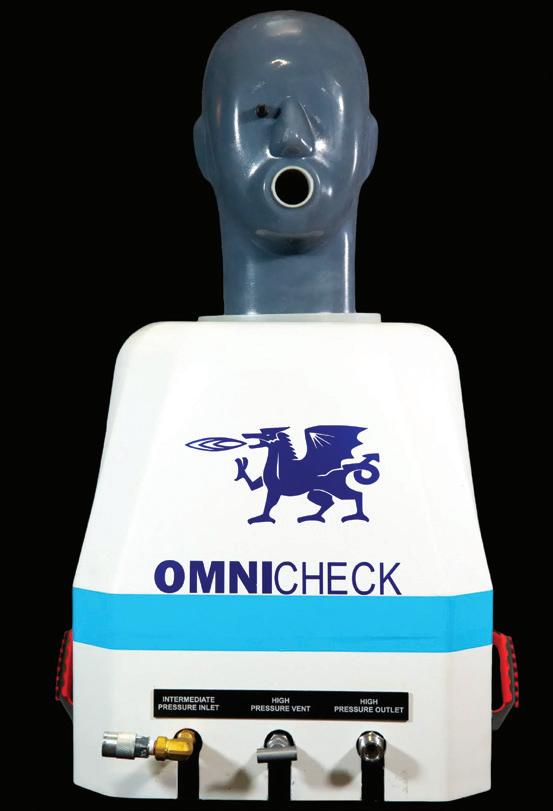
In Africa, the hand that rocks the cradle also tills the field. In addition to raising children, preparing food, carrying water and collecting firewood, African women do up to 80% of the farm work. But they get as little as 5% of the support - in training, seeds, land and credit. You can change this. Add your name to the petition to demand increased support for African women farmers. Find out more at www.changeherlife.org




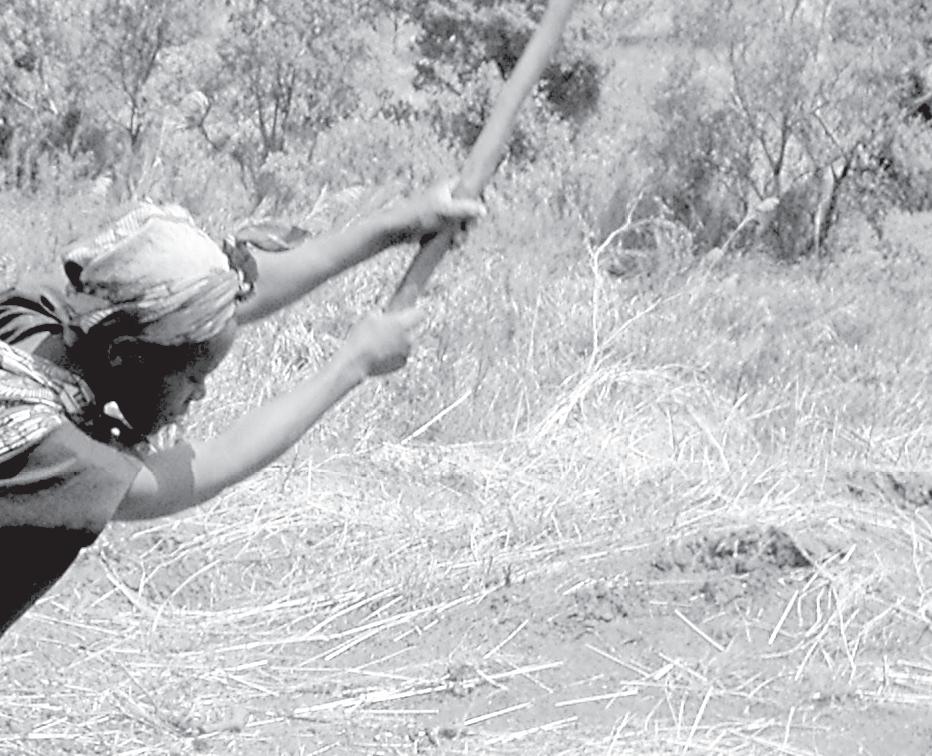


Author: Bob Mortimer
Publisher: Gallery Books
Price: €17.99
As he continues to delight TV viewers with his onscreen partnership with Paul Whitehouse in Gone Fishing, Bob Mortimer has also almost e ortlessly solidi ed his position as an author of very enjoyable cosy crime ction.
Following the success of his debut novel e Satsuma Complex, he picks up where he le o with the story of solicitor Gary and his now-girlfriend Emily in the months a er they exposed a case of police corruption. As they await the trial in which they both may have to act as key witnesses, Emily has moved to Brighton to renovate and take over the running of her now deceased father’s hotel, e Avocado, while cautious Gary remains in London, unsure whether to take the plunge, leave his comfortable but humdrum life in Peckham, and move in with his eminently patient girlfriend.
A visit to his o ce by an unnervingly shady character named Clive Sequence quickly turns events on their head as its revealed he and his sidekick are working for the corrupt policemen who face serious jail time, and will stop at nothing to prevent Gary and Emily from testifying in the trial.
With his phone tapped, the hesitant Gary has to gure out how to escape the ever-present gaze of the menacing Sequence, his lack of knowledge of a shady underworld constantly getting him into more and more dangerous territory. Caught between a rock and a hard place, he has to bite the bullet and decide whether to take the easy options – regarding the trial, his commitment to Emily, his job – or do the right thing in each case and in the process risk his life and the lives of his friends.
Although the plot is not as intriguing as his rst novel (which you should read before starting this one), Mortimer’s success lies not in the strength of his stories but in the way he tells them, instantly jumping from dramatic scenes to humorous and sometimes bizarre ights of fancy and irrelevant musings on things such as the merits of Battenberg cake and having your face pushed into raw mincemeat.
It’s clear from this sequel that the author is thoroughly enjoying the platform provided by his debut’s success, with a lot more freedom to write the type of story he wants to deliver in his own way, and fans of his Athletico Mince podcast will be delighted to see him subtly introduce hints of some of his best characters from that side project.
e same side characters that brought weight and drama to e Satsuma Complex through their sub-plots all make an appearance here, but Mortimer also introduces some new and enjoyable faces that will only add to the cast of what will almost certainly be a third novel, and a TV adaptation.
It won’t be the most complex crime novel you come across this year, but this is a very enjoyable, fun read that will keep you entertained on every page.

As reigning All-Ireland champions with back-to-back league titles and four consecutive Leinster championships under their belt, Dublin’s GAA team was flying as they began the All-Ireland semifinal against Donegal in August 2014. Nobody expected them to lose, but the Ulstermen ambushed them to come out victorious. Rather than heralding the end of an era, it was the start of seven glorious years for the Dubs, with manager Jim Gavin improving the squad year on year to deliver six All-Ireland titles in a row, remaining undefeated in the championship for 2,540 days. In this very interesting read, sports journalist Eric Haughan examines this era of dominance, speaking to players and backroom sta , and reviewing crucial matches to piece together what it was that made this team so successful for so long. As a club player and coach, the author’s love for the game is evident throughout this work that is packed with great insights into what drives a winning team to continue to overcome their rivals. A great read for any Dubs fan.
AUTHOR: JOHNNY SEXTON PUBLISHER: SANDYCOVE PRICE: €24.99
AUTHOR: ERIC HAUGHAN PUBLISHER: O’BRIEN PRESS PRICE: €19.99

The bookshelves are full of autobiographies of recently retired Irish rugby players, but this latest from Johnny Sexton, written with journalist Peter O’Reilly, truly stands out as one of the best of its kind. Arguably Ireland’s best ever player, Sexton has often been portrayed as a prickly character who was never afraid to speak his mind to fellow players, coaches and referees, and true to form, he pulls no punches here in his assessment of key moments in his sporting and personal life. As well as great insights into the game, there are many enjoyable anecdotes from his playing career that he recalls, including every compliment and perceived slight, with the same precise detail he shows in remembering every match he ever played in. What makes this fascinating is Sexton’s account of his extraordinary determination to succeed in the face of numerous doubters who thought his chance had passed when at 23 he still hadn’t broken into the Leinster team. The same intense focus and honesty that underlined a glowing career in which he held nothing back is seen throughout this excellent book.

Although Tayto brought out an ‘autobiography’ of Mr Tayto in 2009 called The Man Inside the Jacket, the company has taken the opportunity to celebrate its 70th anniversary with this clever and funny new title by popular historian Bobby Aherne. Charting the rise of Ireland’s most famous crisp manufacturer from its humble beginnings when Joe ‘Spud’ Murphy opened a small factory near the Moore Street market, to establishing itself as an iconic brand, it gives an entertaining look at the crisp’s evolution in a changing Ireland. Detailing the invention of the cheese and onion flavour and hand-packed paper bags in 1954, to Mr Tayto’s election campaign, the search for Mrs Tayto and the establishment of Tayto Park, it is more than just the story of the crisp, but an irreverent and nostalgic look at our relationship with it, accompanied by brilliant illustrations and images from the archives. Importantly, for every book sold, Tayto will donate €1 to Alone.
AUTHOR: BOBBY AHERNE PUBLISHER: SITRIC BOOKS/ LILLIPUT PRESS PRICE: €19.95










Children’s li ves shouldn’ t need saving from entirely preventable causes. Every day tens of thousands of children worldwide die needlessly from illnesses such as measles, tetanus and diarrhoea. UNICEF wants you to help prevent these deaths. We believe that one child dying is one too many We believe in zero and we desperately need your help. Call 01 878 30 0 0 or visit unicef.ie today to give your support.